Getac Technology AP6234E WLAN module User Manual Module
Getac Technology Corporation WLAN module Module
Contents
- 1. User Manual Host
- 2. User Manual Module
User Manual Module
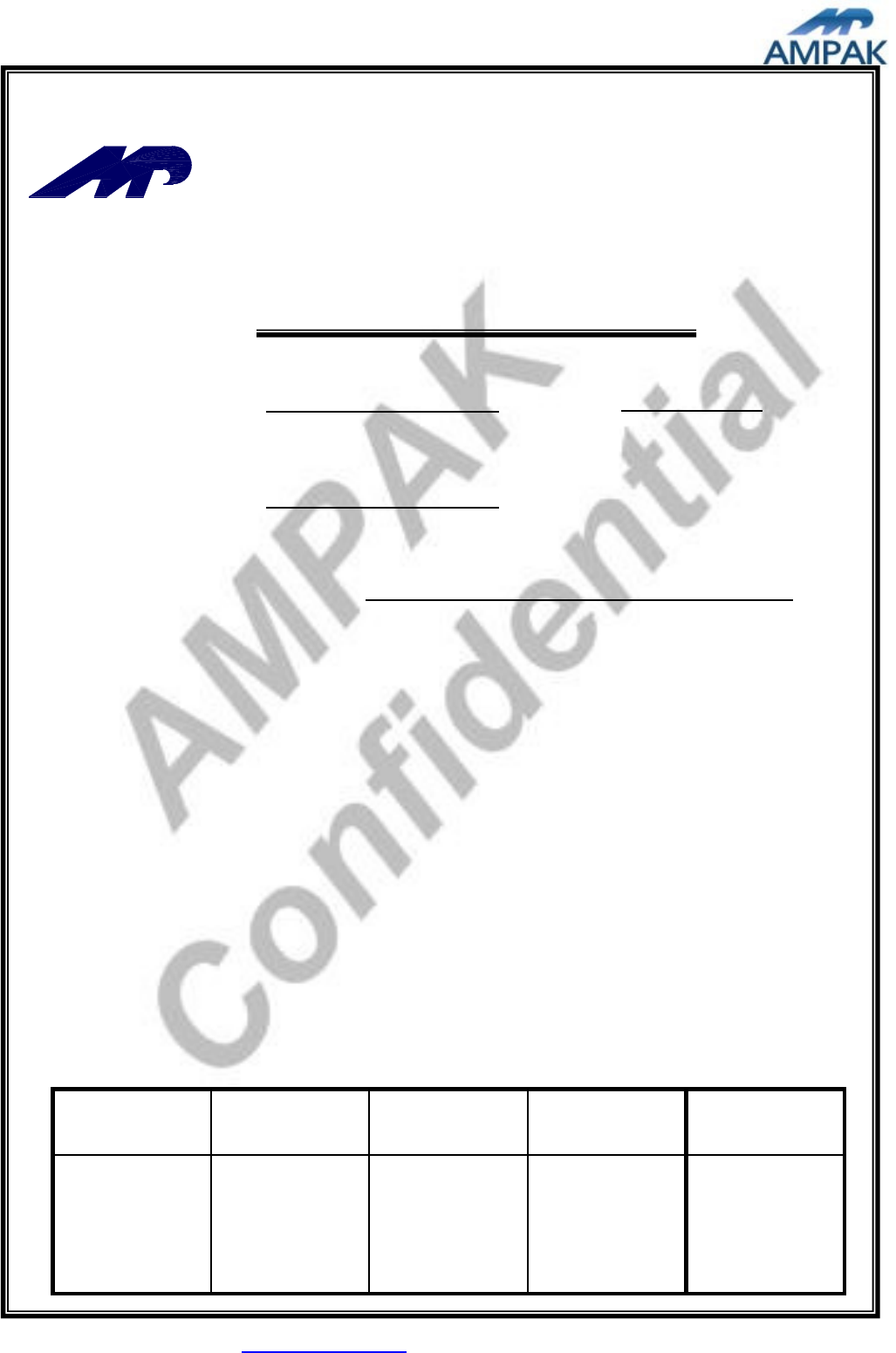
AMPAK Technology Inc. www.ampak.com.tw Proprietary & Confidential Information
Doc. NO:
正基科技股份有限公司
SPECIFICATION
SPEC. NO.: REV: 1.4
DATE: 10.12. 2013
PRODUCT NAME: AP6234
APPROVED CHECKED PREPARED DCC ISSUE
NAME
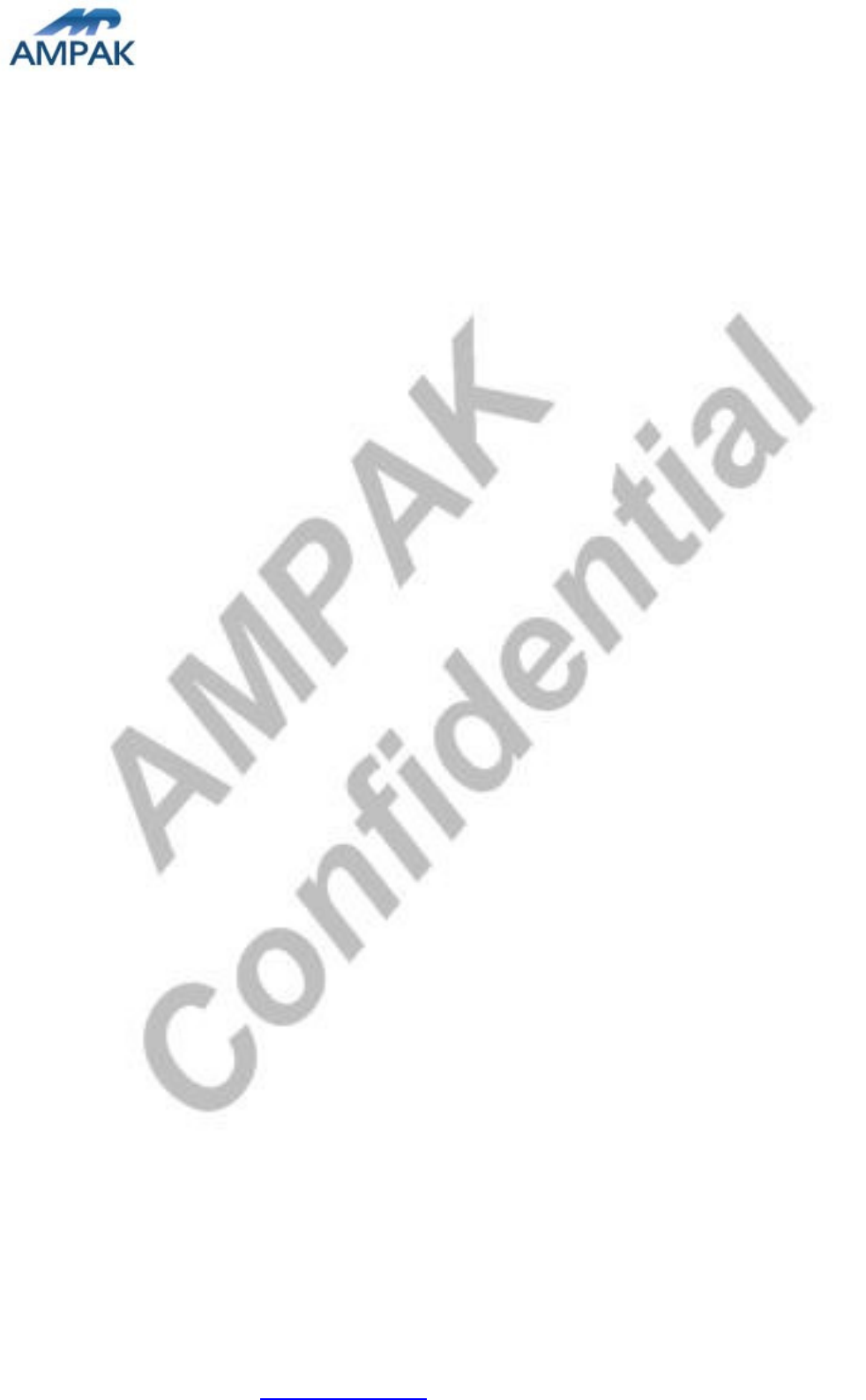
AMPAK Technology Inc. www.ampak.com.tw Proprietary & Confidential Information
Doc. NO:
AMPAK
AP6234
WiFi 11a/b/g/n +Bluetooth 4.0
SIP Module Spec Sheet
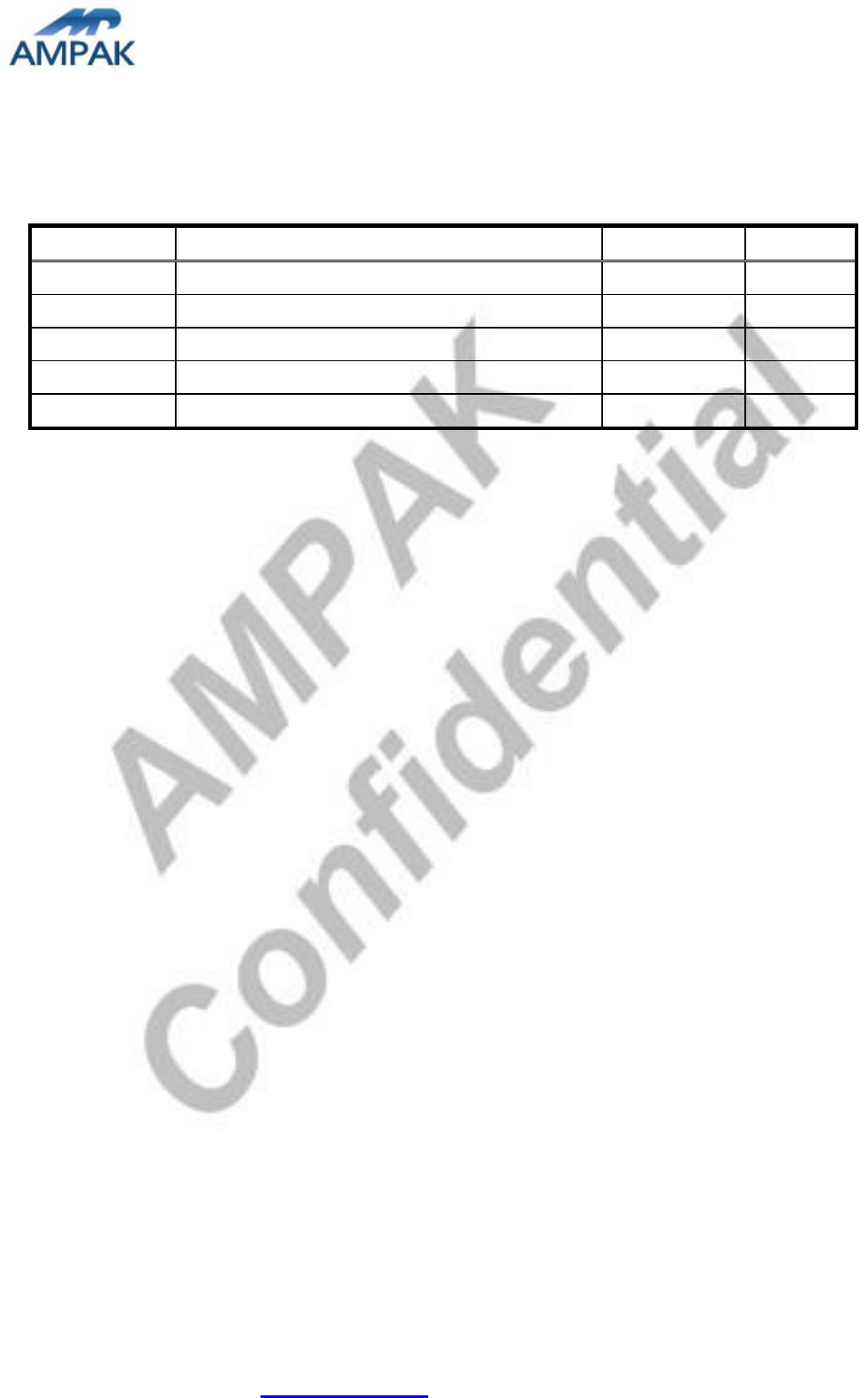
AMPAK Technology Inc. www.ampak.com.tw Proprietary & Confidential Information
Doc. NO:
1
Revision History
Date Revision Content Revised By Version
2012/10/18 - Initial released Brian 1.0
2012/12/18 - Pin definition modify Joe 1.1
2013/01/23 - Pin definition modify Joe 1.2
2013/04/26 - Specification modify Joe 1.3
2013/10/12 - Block Diagram modify Brian 1.4
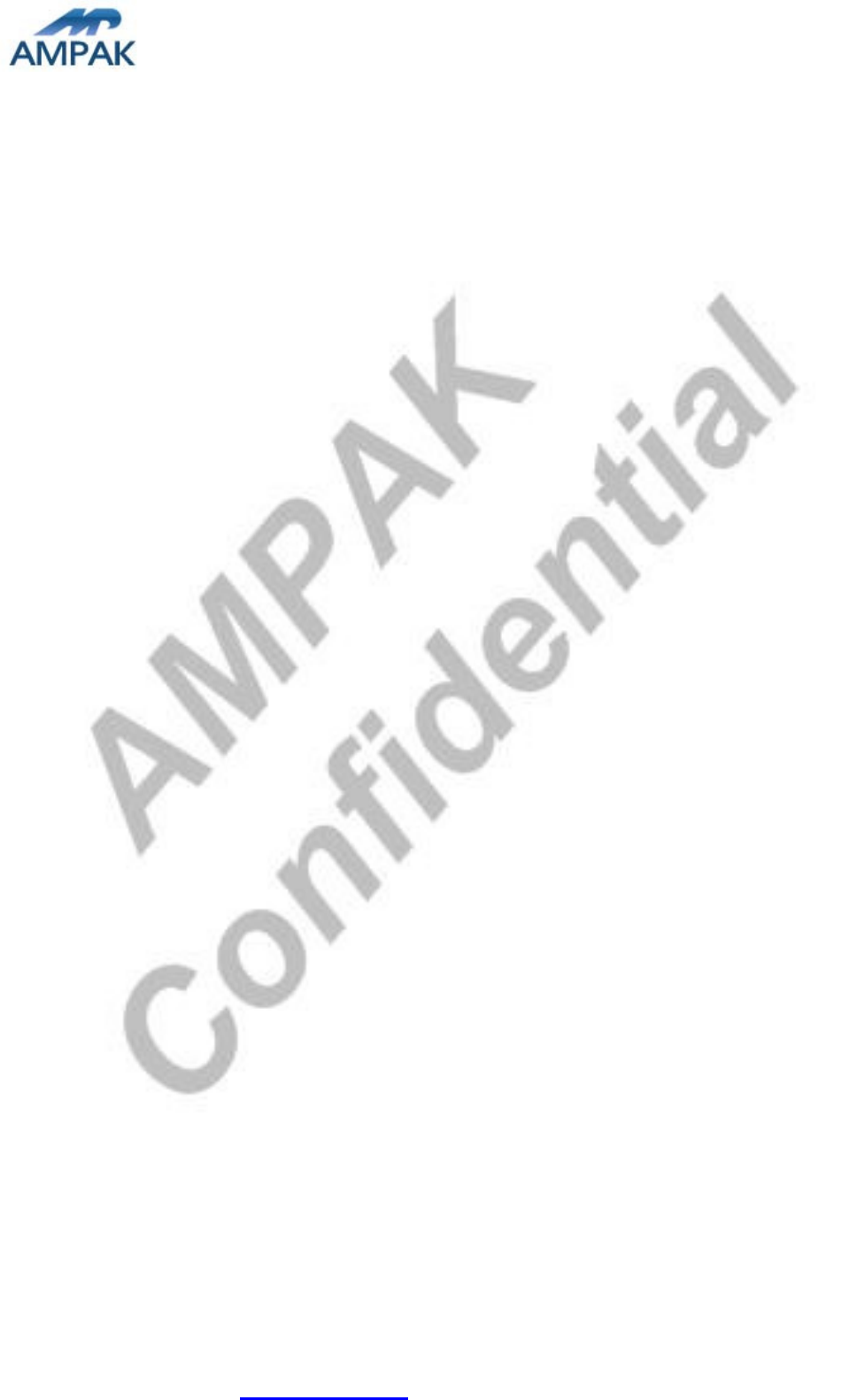
AP6234 Datasheet
AMPAK Technology Inc. www.ampak.com.tw Proprietary & Confidential Information
Doc. NO:
2
Contents
Contents ................................................................................................................... 2
1.Introduction ......................................................................................................... 3
2.Features ............................................................................................................... 4
3.Deliverables ........................................................................................................ 5
3.1 Deliverables .................................................................................................... 5
3.2 Regulatory certifications ................................................................................. 5
4.General Specification ......................................................................................... 6
4.1 General Specification ...................................................................................... 6
4.2 Voltages .......................................................................................................... 6
4.2.1 Absolute Maximum Ratings .................................................................... 6
4.2.2 Recommended Operating Rating ........................................................... 6
The module requires two power supplies: VBAT and VDDIO. ......................... 6
5.WiFi RF Specification ......................................................................................... 7
5.1 2.4GHz & 5GHz RF Specification ................................................................... 7
6.Bluetooth Specification ...................................................................................... 9
6.1 Bluetooth Specification ................................................................................... 9
7.Pin Assignments ............................................................................................... 10
7.1 Pin Outline .................................................................................................... 10
7.2 Pin Definition ................................................................................................ 10
8.Dimensions ....................................................................................................... 12
8.1 Physical Dimensions..................................................................................... 12
8.2 Layout Recommendation .............................................................................. 13
9.External clock reference .................................................................................. 14
9.1 SDIO Pin Description .................................................................................... 14
10.Host Interface Timing Diagram ........................................................................ 15
10.1 Power-up Sequence Timing Diagram ......................................................... 15
10.2 SDIO Default Mode Timing Diagram........................................................... 17
10.3 SDIO High Speed Mode Timing Diagram ................................................... 18
11.Recommended Reflow Profile ......................................................................... 19
12. Package Information ........................................................................................ 20
12.1Label ............................................................................................................ 20
Label C Inner box label . .................................................................................... 20
Label D Carton box label . ................................................................................. 20
12.2 Dimension ................................................................................................... 21
12.3 MSL Level / Storage Condition ................................................................... 23
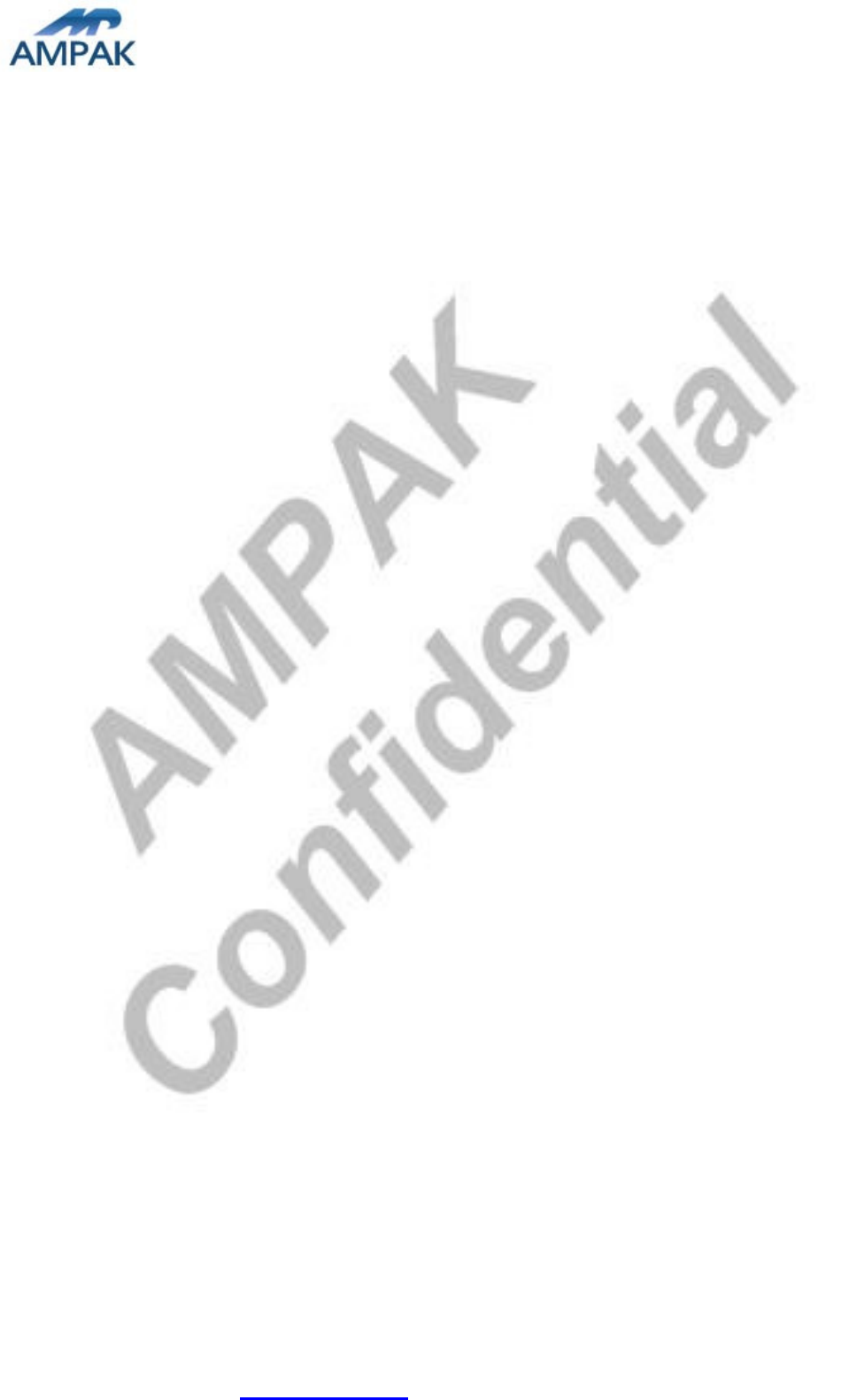
AP6234 Datasheet
AMPAK Technology Inc. www.ampak.com.tw Proprietary & Confidential Information
Doc. NO:
3
1. Introduction
AMPAK Technology would like to announce a low-cost and low-power consumption module,
with integrated dual band (2.4GHz/5GHz) IEEE 802.11 a/b/g and single-stream IEEE
802.11n MAC/baseband/radio and Bluetooth 4.0.
The integrated module provides SDIO V2.0 Host interface for Wi-Fi, high-speed UART is
provided for the Bluetooth Host interface.
This compact module is a total solution for a combination of Wi-Fi dual mode + BT4.0
technologies. The module is specifically developed for mobiles, tablets or handheld wireless
system devices.
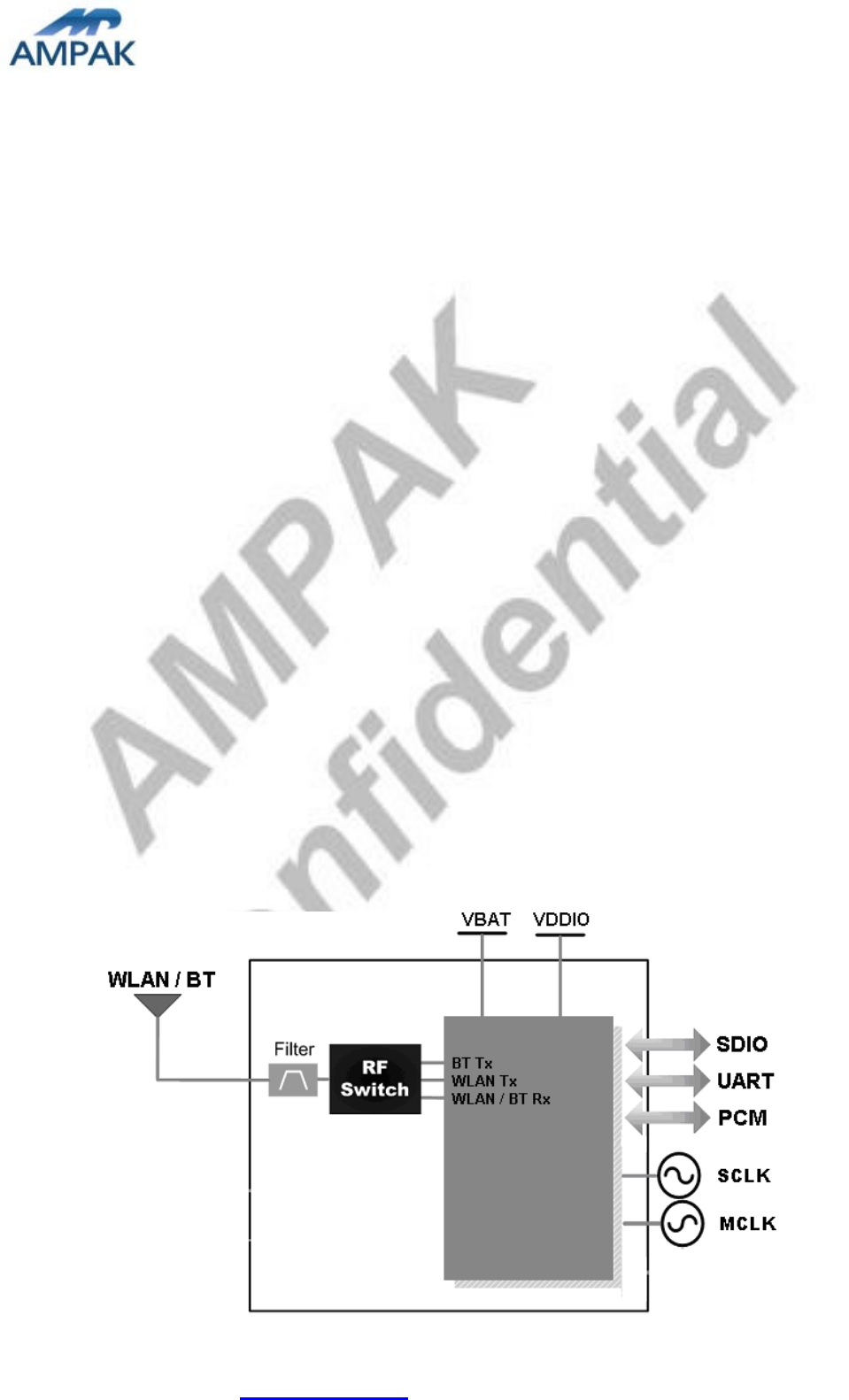
AP6234 Datasheet
AMPAK Technology Inc. www.ampak.com.tw Proprietary & Confidential Information
Doc. NO:
4
2. Features
IEEE 802.11x Key Features
• Dual-band 2.4GHz/5GHz 802.11a/b/g/n.
• Single-stream IEEE 802.11n support for 20MHz and 40MHz channels
provides PHY layer rates up to 150Mbps.
• WLAN host interface options: SDIO v2.0 — up to 50 MHz clock rate
• Support a single antenna shared between WLAN and Bluetooth.
• Security: WEP, WPS, WPA, WPA2, WMM, WAPI, AES,…
Bluetooth Features
• Bluetooth V4.0(BLE) Low Energy with provisions for supporting future
specifications.
• Bluetooth Class1 or Class2 transmitter operation.
• BT host digital interface UART(up to 4 Mbps) with support all Bluetooth4.0
package types
• Multipoint operation with up to seven active ACL links, three active SCO and
eSCO connections.
• Full support for power savings modes (standard sniff, deep sleep modes)
• ECI - enhanced coexistence support, ability to coordinate BT SCO
transmissions around WLAN receives
A simplified block diagram of the module is depicted in the figure below.
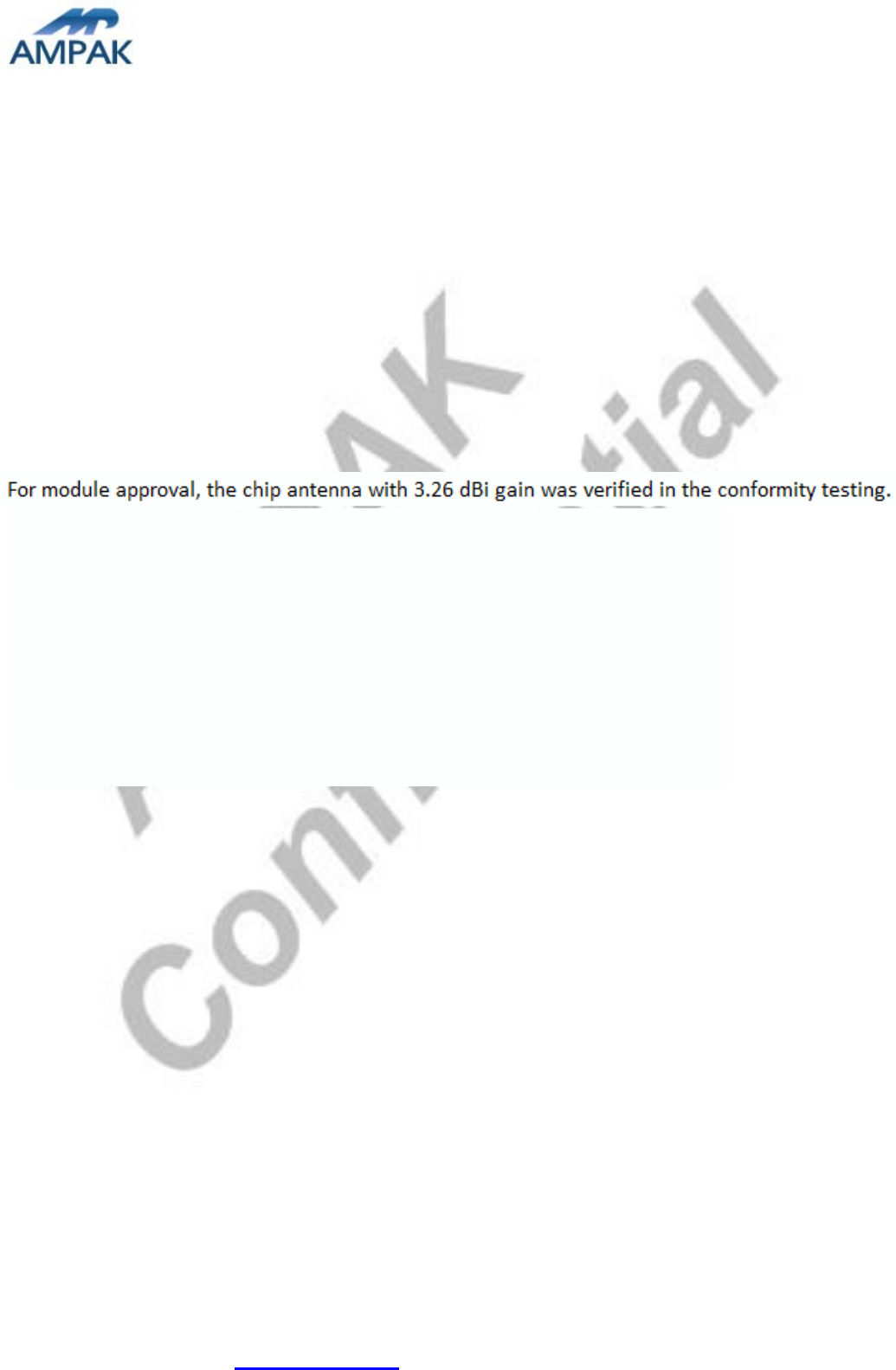
AP6234 Datasheet
AMPAK Technology Inc. www.ampak.com.tw Proprietary & Confidential Information
Doc. NO:
5
3. Deliverables
3.1 Deliverables
The following products and software will be part of the product.
Module with packaging
Evaluation Kits
Software utility for integration, performance test.
Product Datasheet.
Agency certified pre-tested report with the adapter board.
3.2 Regulatory certifications
The product delivery is a pre-tested module, without the module level certification. For
module approval, the platform’s antennas are required for the certification.
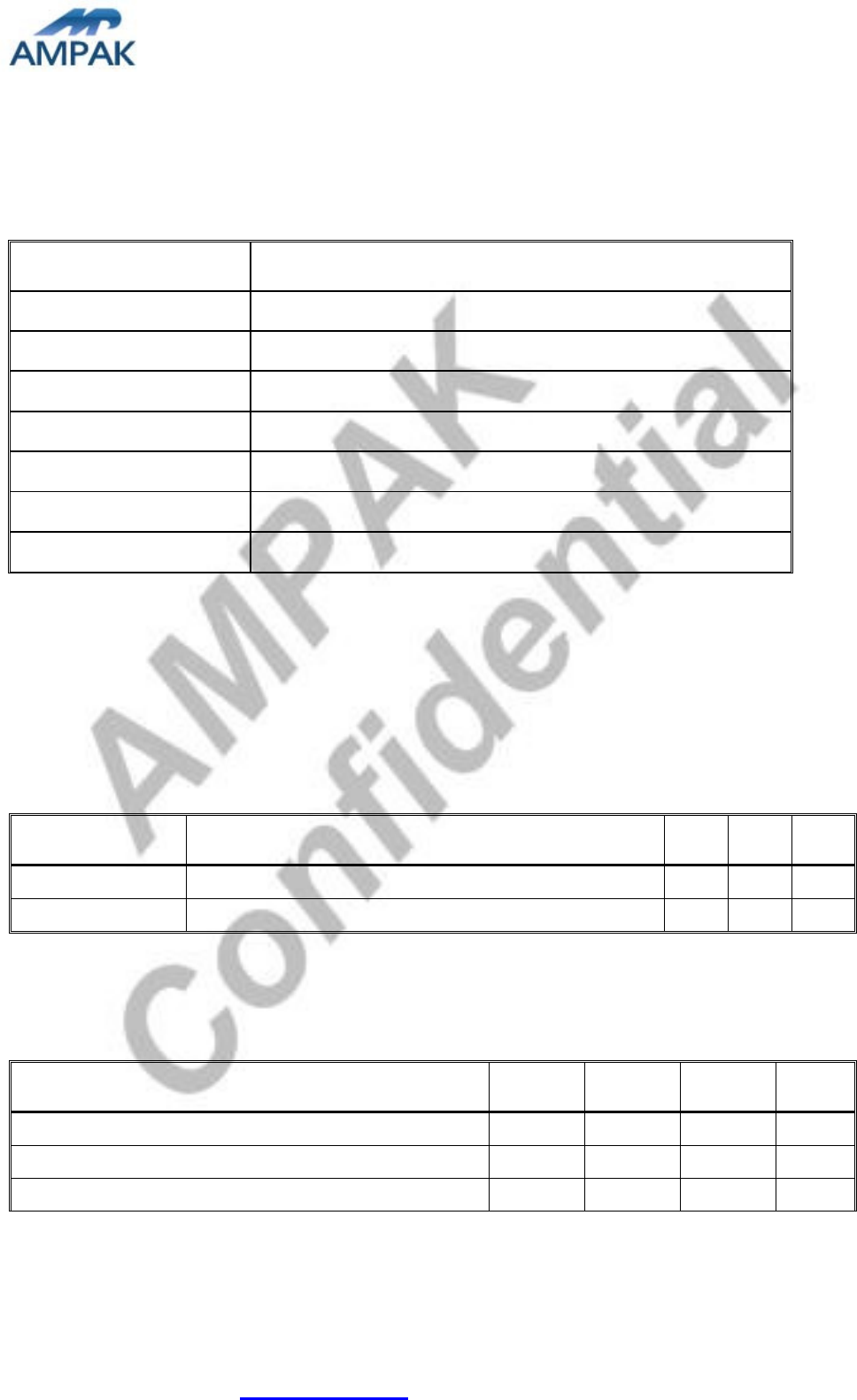
AP6234 Datasheet
AMPAK Technology Inc. www.ampak.com.tw Proprietary & Confidential Information
Doc. NO:
6
4. General Specification
4.1 General Specification
4.2 Voltages
4.2.1 Absolute Maximum Ratings
Symbol Description Min. Max. Unit
VBAT Input supply Voltage -0.5 5 V
VDDIO Digital/Bluetooth/SDIO/ I/O Voltage -0.5 3.6 V
4.2.2 Recommended Operating Rating
The module requires two power supplies: VBAT and VDDIO.
Min. Typ. Max. Unit
Operating Temperature -30 25 85 deg.C
VBAT 3.0 3.6 4.8 V
VDDIO 1.6 3.3 3.4 V
Model Name AP6234
Product Description Supports Wi-Fi dual mode /Bluetoothfunctionalities
Dimension L x W x H: 12.0 x 12.0 x 1.5 (typical) mm
WiFi Interface SDIOV2.0
BT Interface UART/ PCM
Operating temperature -30°C to 85°C
Storage temperature -40°C to 85°C
Humidity Operating Humidity 10% to 95% Non-Condensing
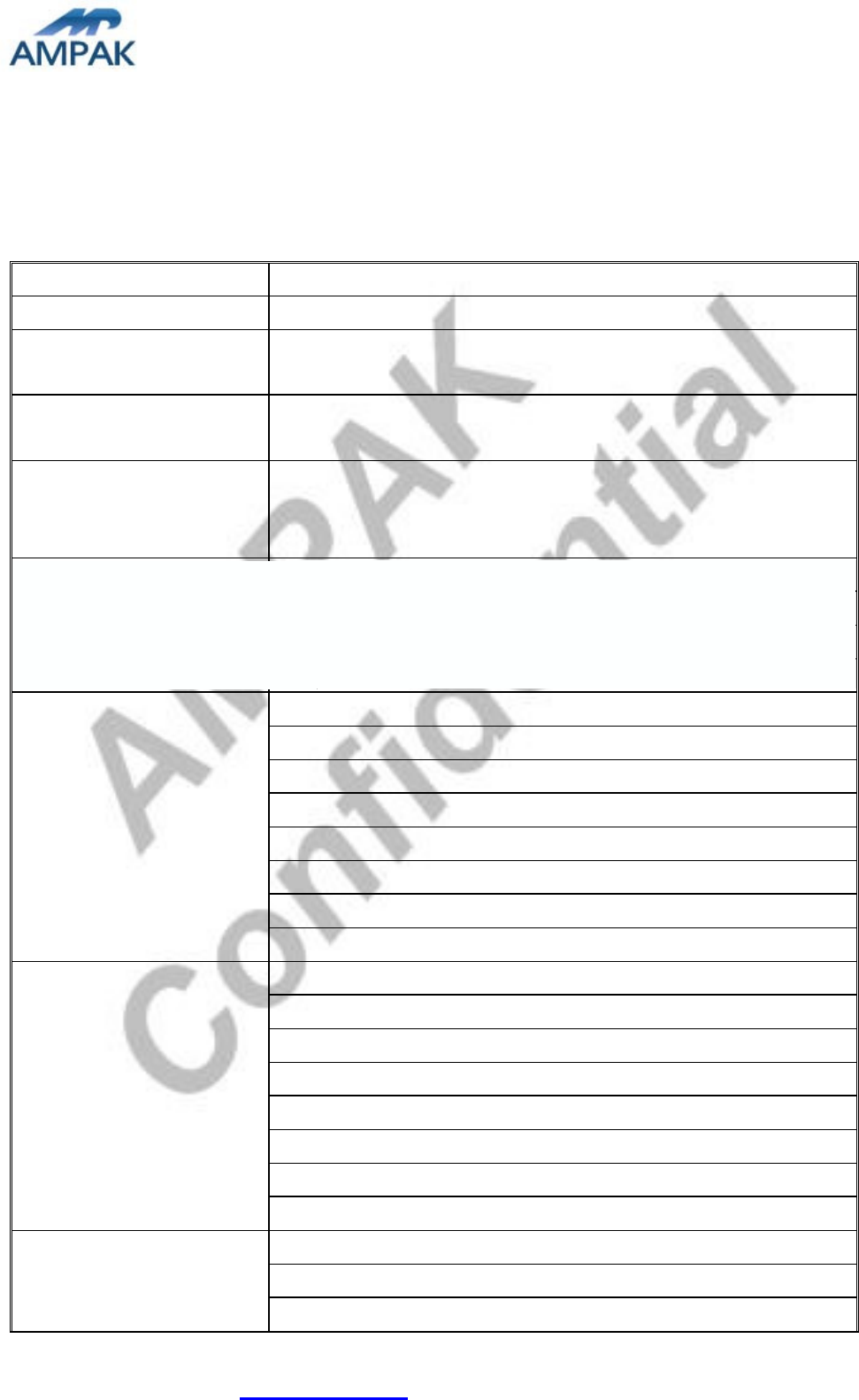
AP6234 Datasheet
AMPAK Technology Inc. www.ampak.com.tw Proprietary & Confidential Information
Doc. NO:
7
5. WiFi RF Specification
5.1 2.4GHz & 5GHz RF Specification
Conditions : VBAT=3.6V ; VDDIO=3.3V ; Temp:25°C
Feature Description
WLAN Standard IEEE 802.11a/b/g/n, WiFi compliant
Frequency Range 2.400 GHz ~ 2.4835 GHz (2.4 GHz ISM Band)
5.150 GHz ~ 5.850 GHz (5.0 GHz ISM Band)
Number of Channels 2.4GHz:Ch1 ~ Ch11
5.0GHz:Please see the table1
Modulation
802.11a : OFDM /64-QAM,16-QAM, QPSK, BPSK
802.11b : DQPSK, DBPSK, CCK
802.11 g/n : OFDM /64-QAM,16-QAM, QPSK, BPSK
Output Power
802.11a /54Mbps : 13 dBm ± 1.5 dB @ EVM -25dB
802.11b /11Mbps : 16 dBm ± 1.5 dB @ EVM -9dB
802.11g /54Mbps : 15 dBm ± 1.5 dB @ EVM -25dB
802.11n /MCS7 : 14 dBm ± 1.5 dB @ EVM -28dB
Receive Sensitivity
(11n,20MHz)
@10% PER
- MCS=0 PER @ -88 dBm, typical
- MCS=1 PER @ -84 dBm, typical
- MCS=2 PER @ -82 dBm, typical
- MCS=3 PER @ -80 dBm, typical
- MCS=4 PER @ -77 dBm, typical
- MCS=5 PER @ -74dBm, typical
- MCS=6 PER @ -72 dBm, typical
- MCS=7 PER @ -70 dBm, typical
Receive Sensitivity
(11n,40MHz)
@10% PER
- MCS=0 PER @ -87 dBm, typical
- MCS=1 PER @ -83 dBm, typical
- MCS=2 PER @ -81 dBm, typical
- MCS=3 PER @ -79 dBm, typical
- MCS=4 PER @ -77 dBm, typical
- MCS=5 PER @ -76 dBm, typical
- MCS=6 PER @ -71 dBm, typical
- MCS=7 PER @ -70 dBm, typical
Receive Sensitivity (11g)
@10% PER
- 6Mbps PER @ -89 dBm, typical
- 9Mbps PER @ -88 dBm, typical
- 12Mbps PER @ -86 dBm, typical
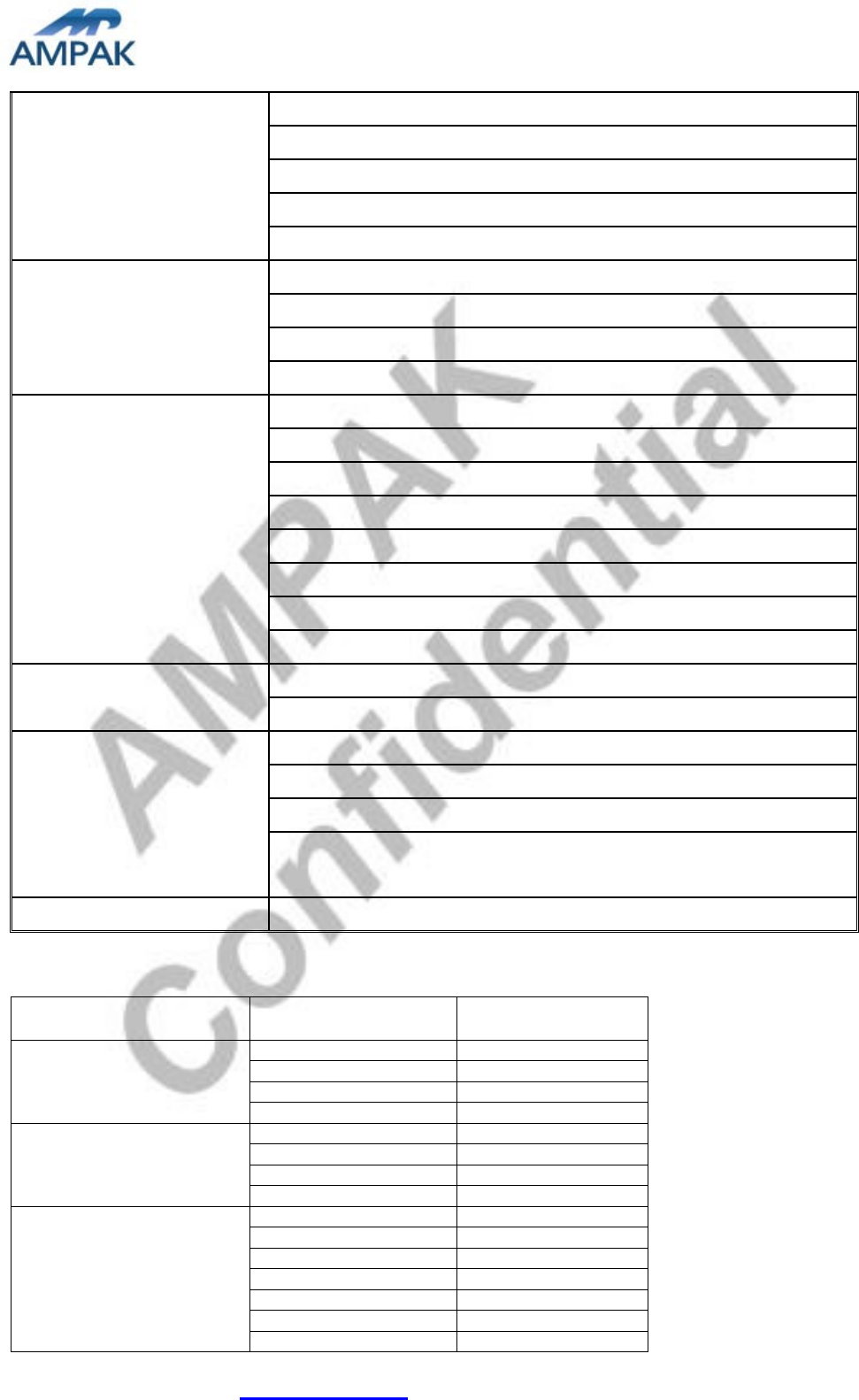
AP6234 Datasheet
AMPAK Technology Inc. www.ampak.com.tw Proprietary & Confidential Information
Doc. NO:
8
- 18Mbps PER @ -84 dBm, typical
- 24Mbps PER @ -82 dBm, typical
- 36Mbps PER @ -78 dBm, typical
- 48Mbps PER @ -75 dBm, typical
- 54Mbps PER @ -73 dBm, typical
Receive Sensitivity (11b)
@8% PER
- 1Mbps PER @ -95 dBm, typical
- 2Mbps PER @ -94 dBm, typical
- 5.5Mbps PER @ -90 dBm, typical
- 11Mbps PER @ -87 dBm, typical
Receive Sensitivity (11a)
@10% PER
- 6Mbps PER @ -88 dBm, typical
- 9Mbps PER @ -86 dBm, typical
- 12Mbps PER @ -84 dBm, typical
- 18Mbps PER @ -82 dBm, typical
- 24Mbps PER @ -80 dBm, typical
- 36Mbps PER @ -78 dBm, typical
- 48Mbps PER @ -75 dBm, typical
- 54Mbps PER @ -73 dBm, typical
Maximum Input Level 802.11b : -10 dBm
802.11a/g/n : -20 dBm
Data Rate
802.11a : 6, 9, 12, 18, 24, 36, 48, 54Mbps
802.11b : 1, 2, 5.5, 11Mbps
802.11g : 6, 9, 12, 18, 24, 36, 48, 54Mbps
802.11n: MCS0, MCS1, MCS2, MCS3, MCS4, MCS5,
MCS6, MCS7
Antenna Reference Small antennas with 0~2 dBi peak gain
15GHz Channel table
Band (GHz) Operating Channel
Numbers
Channel center
frequencies(MHz)
5.15GHz~5.25GHz
36 5180
40 5200
44 5220
48 5240
5.25GHz~5.35GHz
52 5260
56 5280
60 5300
64 5320
5.5GHz~5.7GHz
100 5500
104 5520
108 5540
112 5560
116 5580
120 5600
124 5620
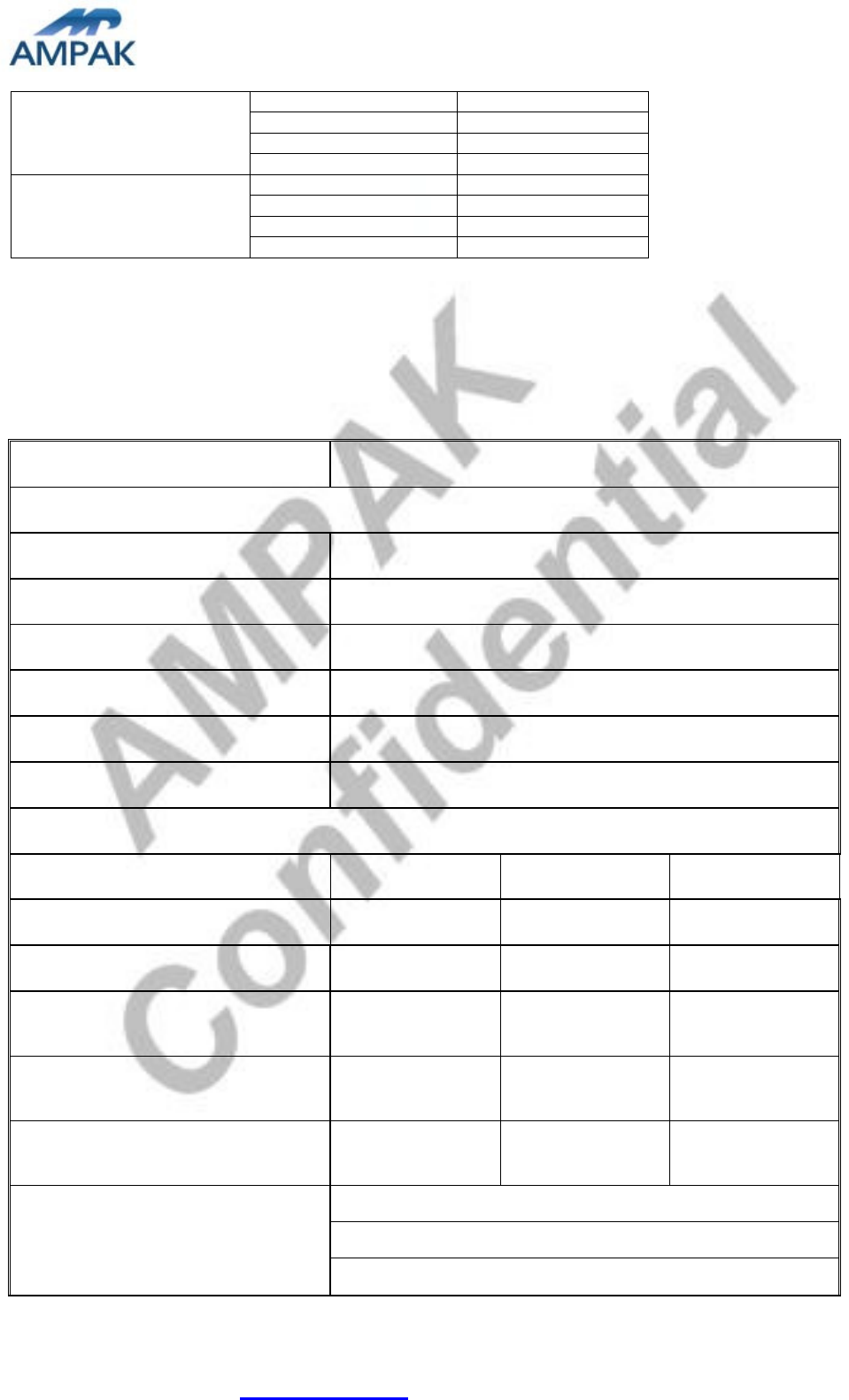
AP6234 Datasheet
AMPAK Technology Inc. www.ampak.com.tw Proprietary & Confidential Information
Doc. NO:
9
128 5640
132 5660
136 5680
140 5700
5.725GHz~5.825GHz
149 5745
153 5765
157 5785
161 5805
6. Bluetooth Specification
6.1 Bluetooth Specification
Conditions : VBAT=3.6V ; VDDIO=3.3V ; Temp:25°C
Feature Description
General Specification
Bluetooth Standard Bluetooth V4.0 of 1, 2 and 3 Mbps.
Host Interface UART
Antenna Reference Small antennas with 0~2 dBi peak gain
Frequency Band 2.400 GHz ~ 2483.5 GHz
Number of Channels 79 channels
Modulation FHSS, GFSK, DPSK, DQPSK
RF Specification
Min. Typical. Max.
Output Power (Class 1.5) 10 dBm
Output Power (Class 2) 2 dBm
Sensitivity @ BER=0.1%
for GFSK (1Mbps) -86 dBm
Sensitivity @ BER=0.01%
for π/4-DQPSK (2Mbps) -86 dBm
Sensitivity @ BER=0.01%
for 8DPSK (3Mbps) -80 dBm
Maximum Input Level
GFSK (1Mbps):-20dBm
π/4-DQPSK (2Mbps) :-20dBm
8DPSK (3Mbps) :-20dBm
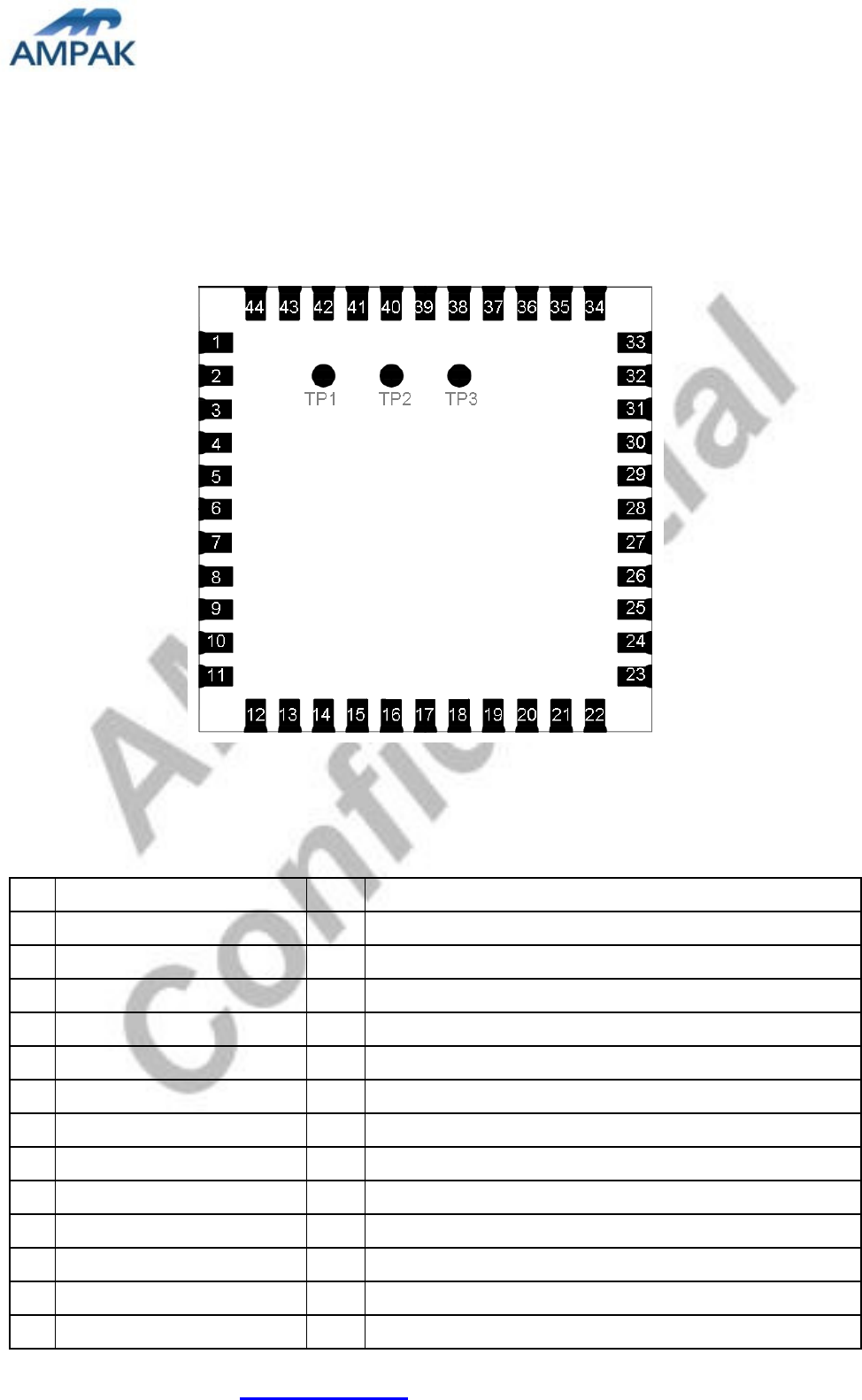
AP6234 Datasheet
AMPAK Technology Inc. www.ampak.com.tw Proprietary & Confidential Information
Doc. NO:
10
7. Pin Assignments
7.1 Pin Outline
< TOP VIEW >
7.2 Pin Definition
NO Name Type Description
1 GND - Ground connections
2 WL_BT_ANT I/O RF I/O port
3 GND - Ground connections
4 NC - Floating (Don’t connected to ground)
5 NC - Floating (Don’t connected to ground)
6 BT_WAKE I HOST wake-up Bluetooth device
7 BT_HOST_WAKE O Bluetooth device to wake-up HOST
8 NC - Floating (Don’t connected to ground)
9 VBAT P Main power voltage source input
10 XTAL_IN I XTAL oscillator input
11 XTAL_OUT O XTAL oscillator output
12 WL_REG_ON I Internal regulators power enable/disable
13 WL_HOST_WAKE O WLAN to wake-up HOST
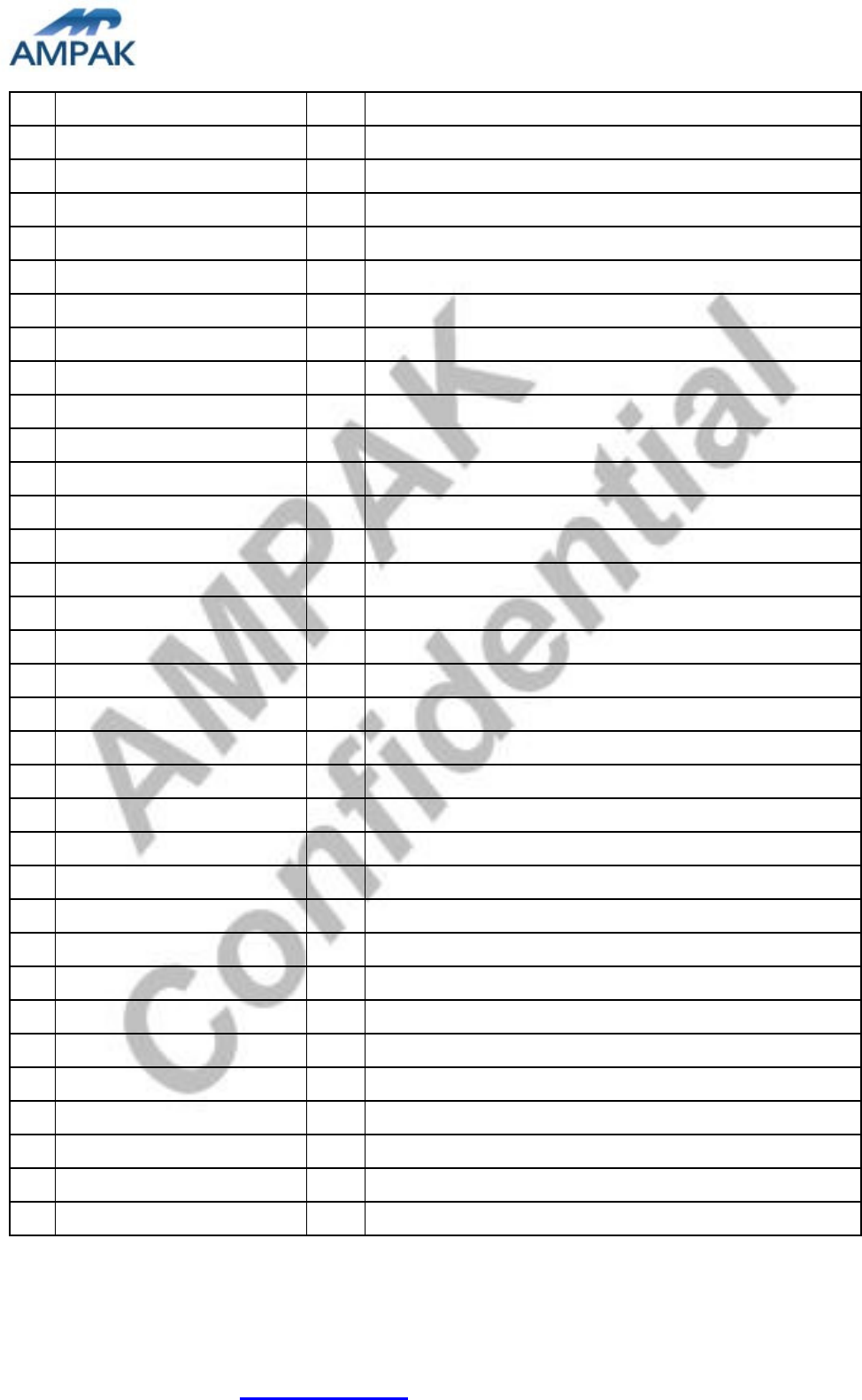
AP6234 Datasheet
AMPAK Technology Inc. www.ampak.com.tw Proprietary & Confidential Information
Doc. NO:
11
14 SDIO_DATA_2 I/O SDIO data line 2
15 SDIO_DATA_3 I/O SDIO data line 3
16 SDIO_DATA_CMD I/O SDIO command line
17 SDIO_DATA_CLK I/O SDIO clock line
18 SDIO_DATA_0 I/O SDIO data line 0
19 SDIO_DATA_1 I/O SDIO data line 1
20 GND - Ground connections
21 VIN_LDO_OUT P Internal Buck voltage generation pin
22 VDDIO P I/O Voltage supply input
23 VIN_LDO P Internal Buck voltage generation pin
24 LPO I Low power oscillator clock input (32.768KHz)
25 PCM_OUT O PCM Data output
26 PCM_CLK I/O PCM clock
27 PCM_IN I PCM data input
28 PCM_SYNC I/O PCM sync signal
29 NC - Floating (Don’t connected to ground)
30 NC - Floating (Don’t connected to ground)
31 GND - Ground connections
32 NC - Floating (Don’t connected to ground)
33 GND - Ground connections
34 BT_RST_N I Low asserting reset for Bluetooth core
35 NC - Floating (Don’t connected to ground)
36 GND - Ground connections
37 NC - Floating (Don’t connected to ground)
38 NC - Floating (Don’t connected to ground)
39 NC - Floating (Don’t connected to ground)
40 NC - Floating (Don’t connected to ground)
41 UART_RTS_N O Bluetooth UART interface
42 UART_TXD O Bluetooth UART interface
43 UART_RXD I Bluetooth UART interface
44 UART_CTS_N I Bluetooth UART interface
45 TP1 - Floating (Don’t connected to ground)
46 TP2 - Floating (Don’t connected to ground)
47 TP3 - Floating (Don’t connected to ground)
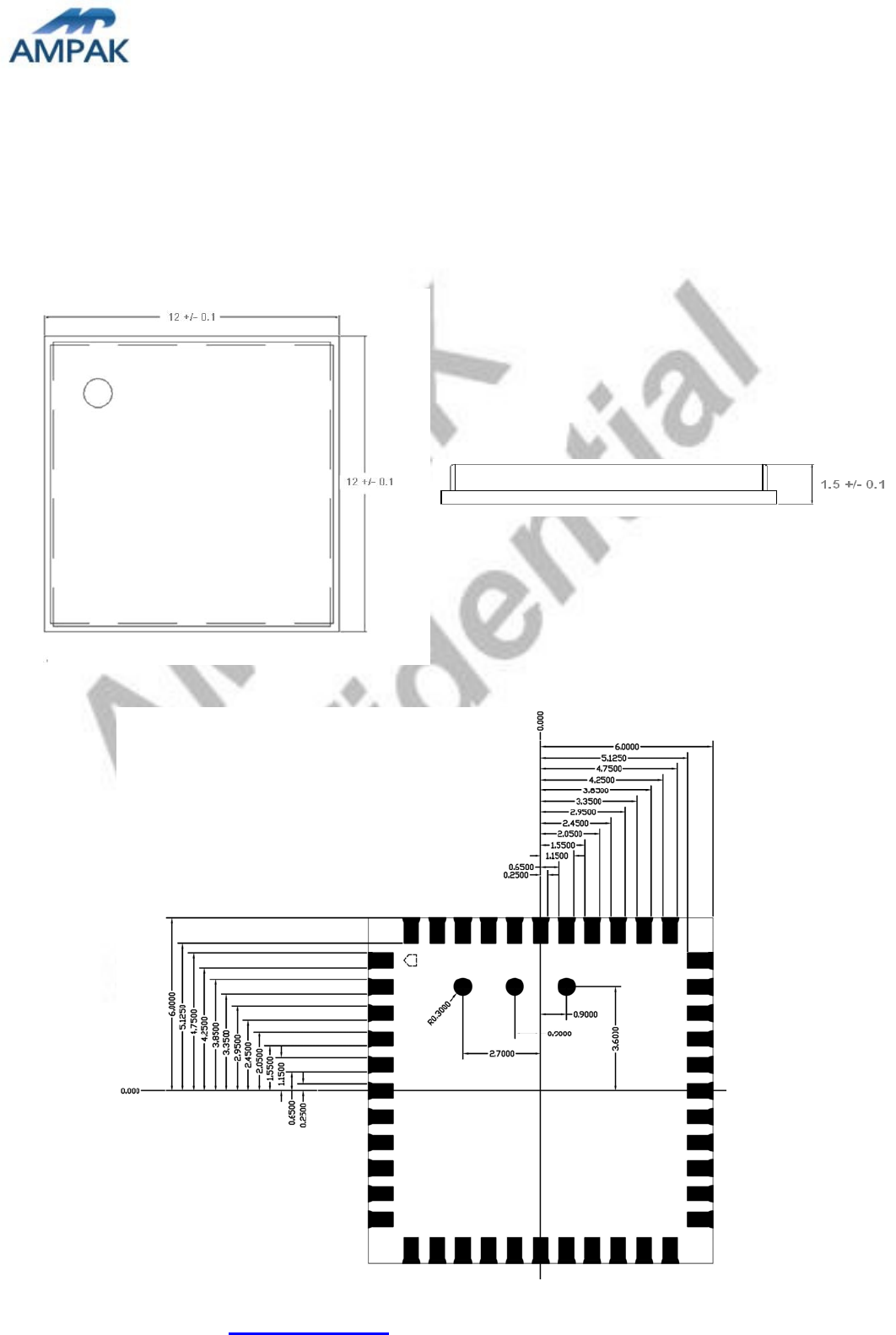
AP6234 Datasheet
AMPAK Technology Inc. www.ampak.com.tw Proprietary & Confidential Information
Doc. NO:
12
8. Dimensions
8.1 Physical Dimensions
(Unit: mm)
< TOP VIEW > < Side View >
< TOP VIEW >
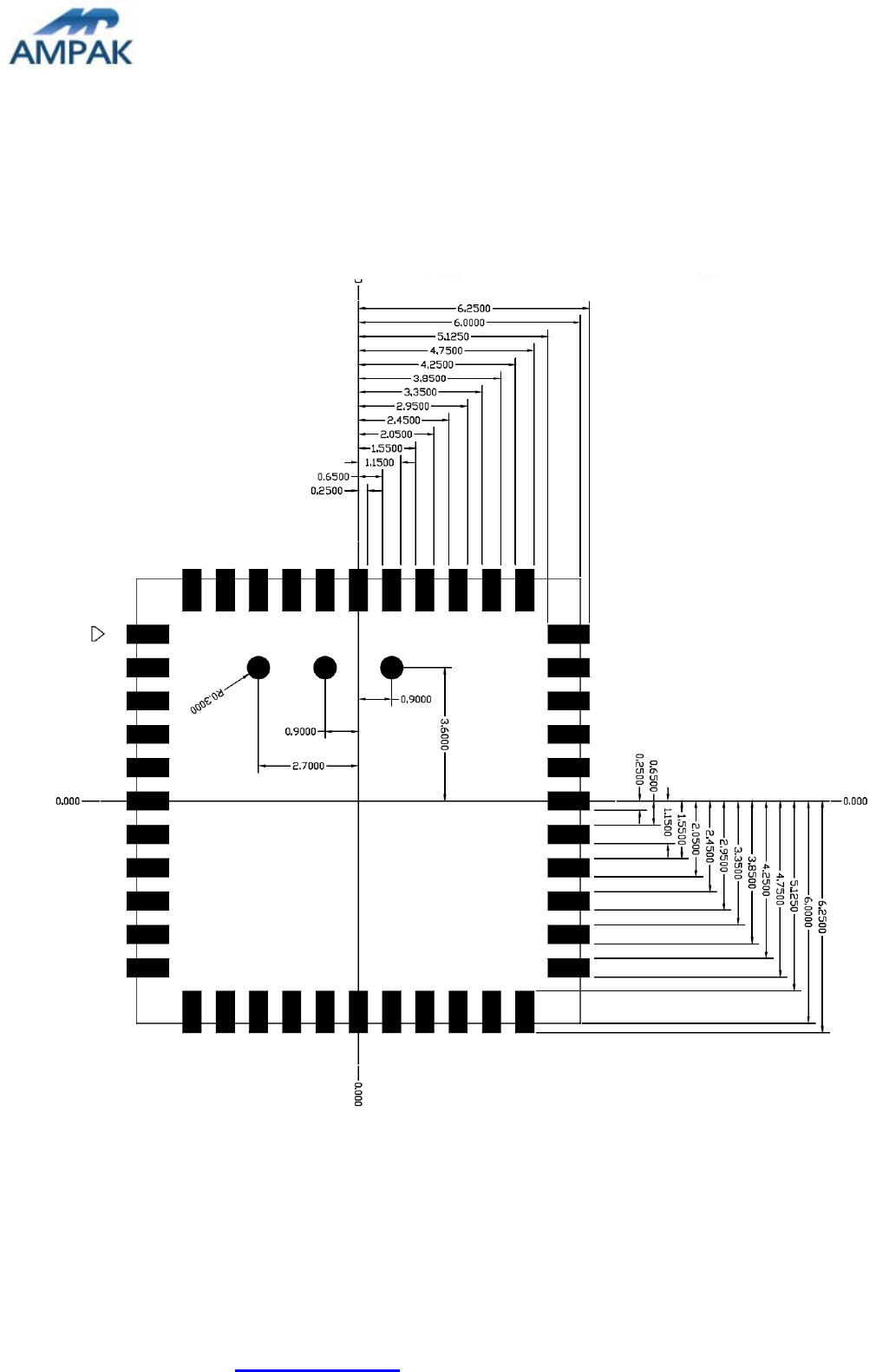
AP6234 Datasheet
AMPAK Technology Inc. www.ampak.com.tw Proprietary & Confidential Information
Doc. NO:
13
8.2 Layout Recommendation
(Unit: mm)
< TOP VIEW >
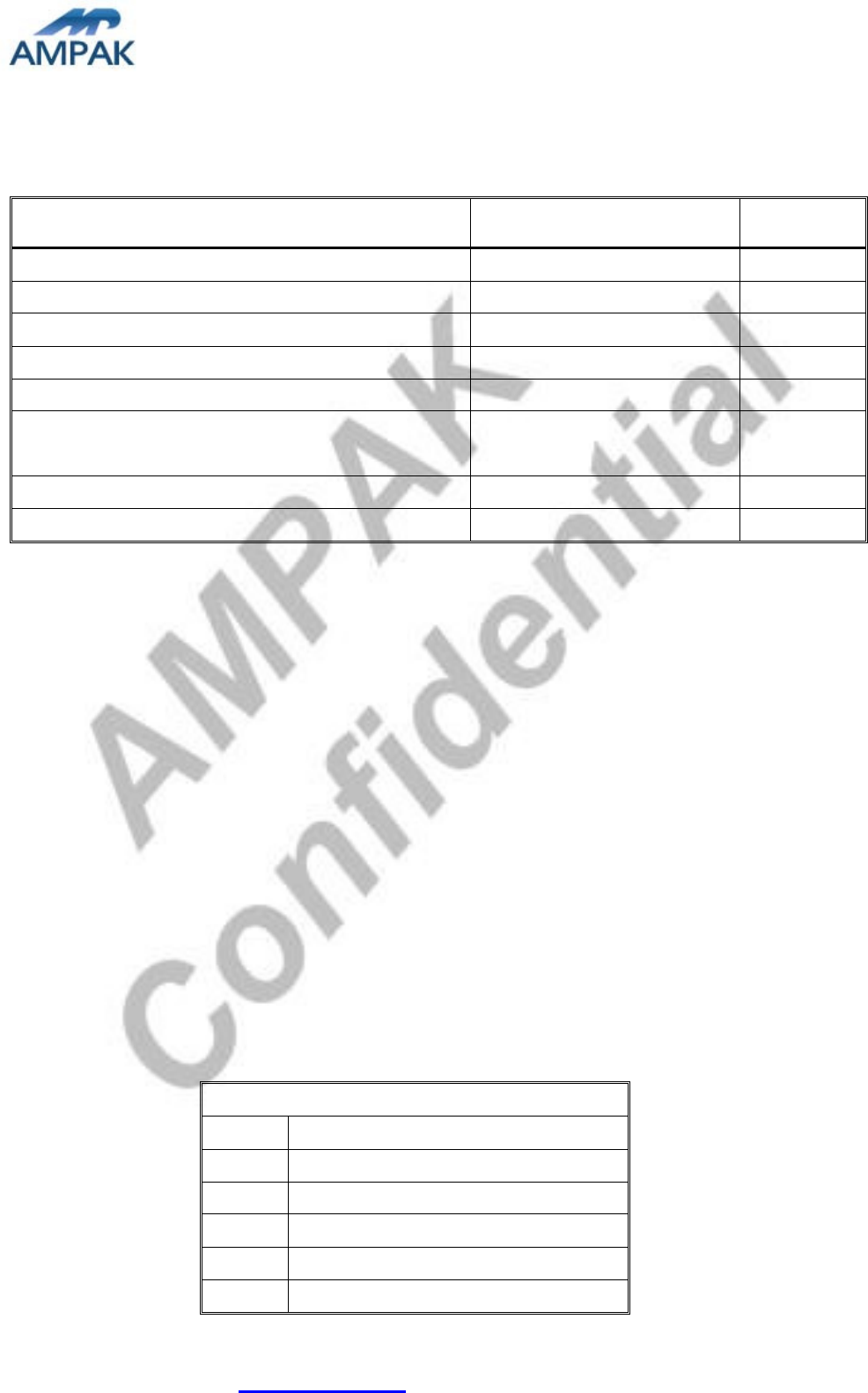
AP6234 Datasheet
AMPAK Technology Inc. www.ampak.com.tw Proprietary & Confidential Information
Doc. NO:
14
9. External clock reference
External LPO signal characteristics
Parameter Specification Units
Nominal input frequency 32.768 kHz
Frequency accuracy 30
ppm
Duty cycle 30 - 70 %
Input signal amplitude 400 to 1800 mV, p-p
Signal type Square-wave -
Input impedance >100k
<5
pF
Clock jitter (integrated over 300Hz – 15KHz) <1 Hz
Output high voltage 0.7Vio - Vio V
9.1 SDIO Pin Description
The module supports SDIO version 2.0 for 4-bit modes (100 Mbps), and high speed 4-bit (50
MHz clocks – 200 Mbps). It has the ability to stop the SDIO clock and map the interrupt
signal into a GPIO pin. This ‘out-of-band’ interrupt signal notifies the host when the WLAN
device wants to turn on the SDIO interface. The ability to force the control of the gated
clocks from within the WLAN chip is also provided.
Function 0 Standard SDIO function (Max BlockSize / ByteCount = 32B)
Function 1 Backplane Function to access the internal System On Chip (SOC)
address space (Max BlockSize / ByteCount = 64B)
Function 2 WLAN Function for efficient WLAN packet transfer through DMA (Max
BlockSize/ByteCount=512B)
SDIO Pin Description
SD 4-Bit Mode
DATA0 Data Line 0
DATA1 Data Line 1 or Interrupt
DATA2 Data Line 2 or Read Wait
DATA3 Data Line 3
CLK Clock
CMD Command Line
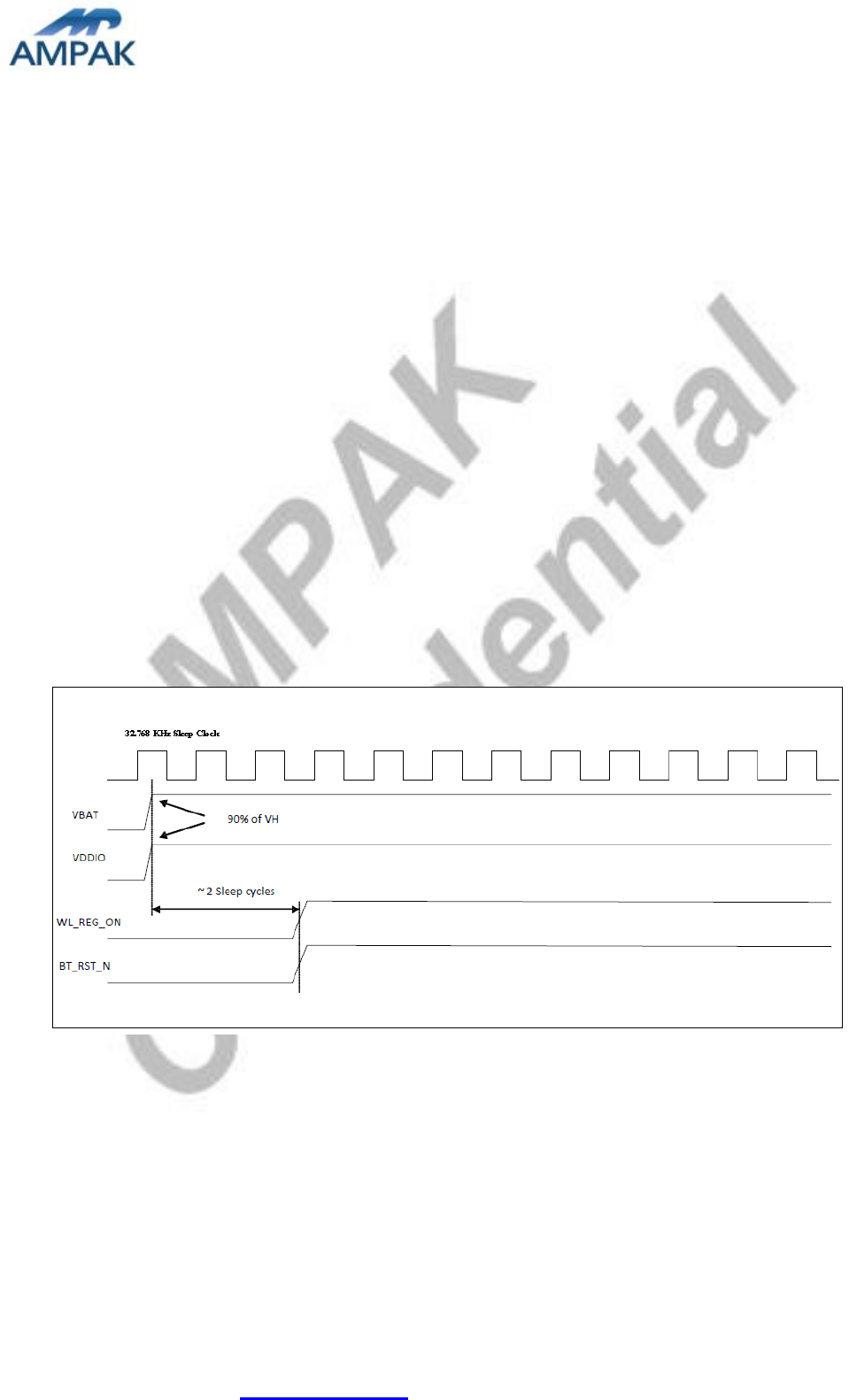
AP6234 Datasheet
AMPAK Technology Inc. www.ampak.com.tw Proprietary & Confidential Information
Doc. NO:
15
10. Host Interface Timing Diagram
10.1 Power-up Sequence Timing Diagram
The module has signals that allow the host to control power consumption by enabling or
disabling the Bluetooth, WLAN and internal regulator blocks. These signals are described
below.
Additionally, diagrams are provided to indicate proper sequencing of the signals for carious
operating states. The timing value indicated are minimum required values: longer delays are
also acceptable.
※ WL_REG_ON: Used by the PMU to power up the WLAN section. When this pin is
high, the regulators are enabled and the WLAN section is out of reset. When this
pin is low the WLAN section is in reset.
※ BT_RST_N: Low asserting reset for Bluetooth only. This pin has no effect on
WLAN and does not control any PMU functions. This pin must be driven high or low
(not left floating).
WLAN=ON, Bluetooth=ON
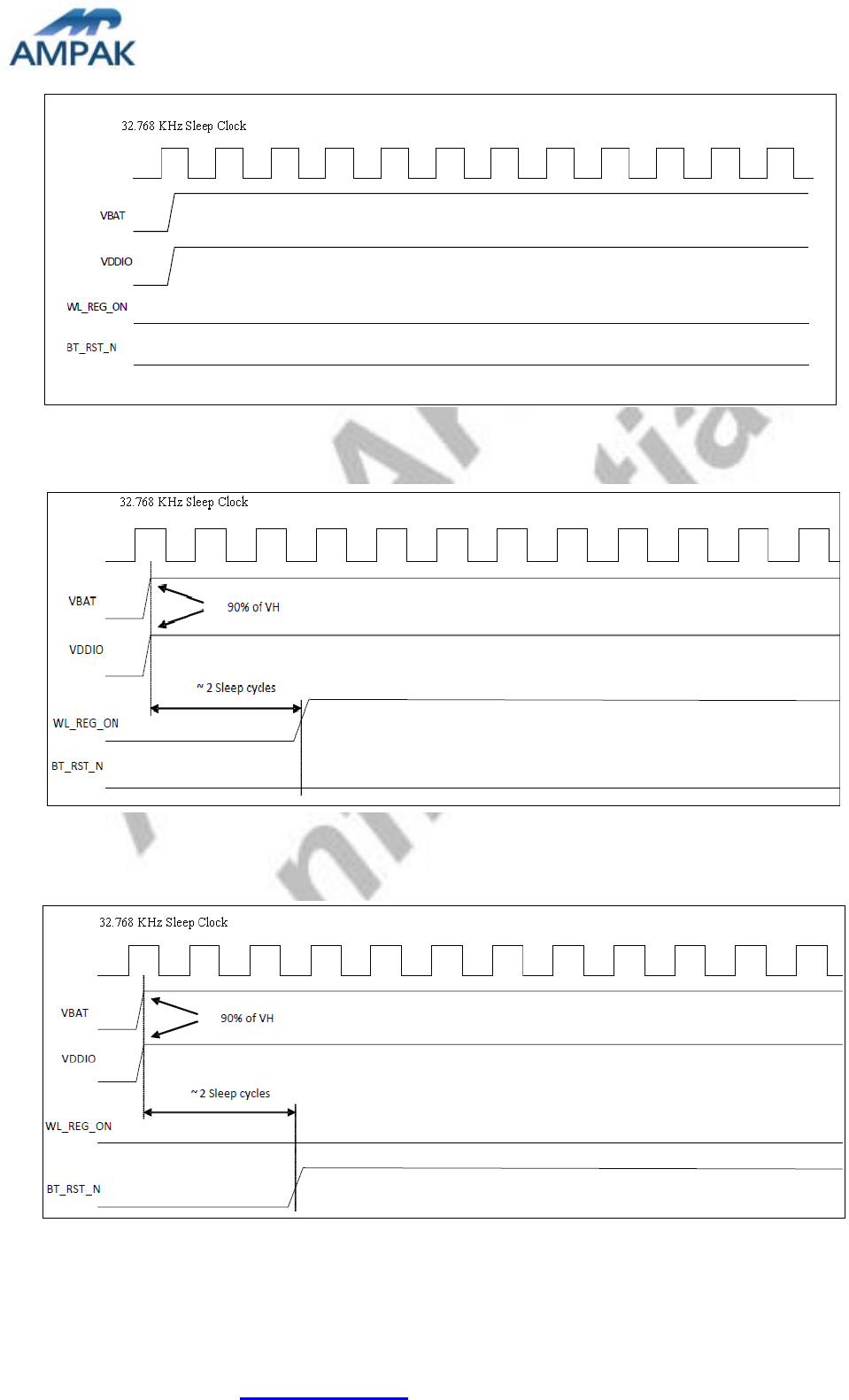
AP6234 Datasheet
AMPAK Technology Inc. www.ampak.com.tw Proprietary & Confidential Information
Doc. NO:
16
WLAN=OFF, Bluetooth=OFF
WLAN=ON, Bluetooth=OFF
WLAN=OFF, Bluetooth=ON
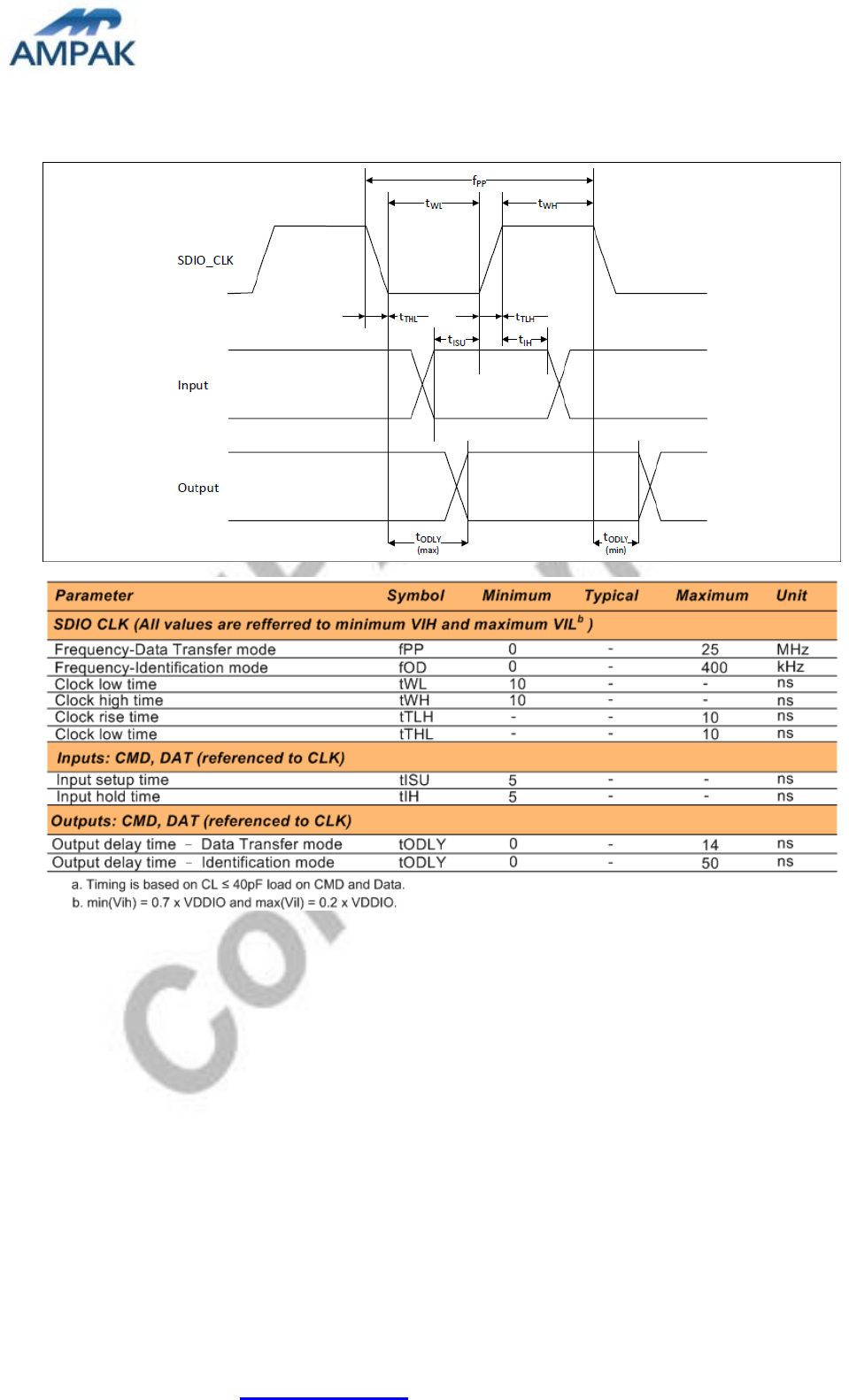
AP6234 Datasheet
AMPAK Technology Inc. www.ampak.com.tw Proprietary & Confidential Information
Doc. NO:
17
10.2 SDIO Default Mode Timing Diagram
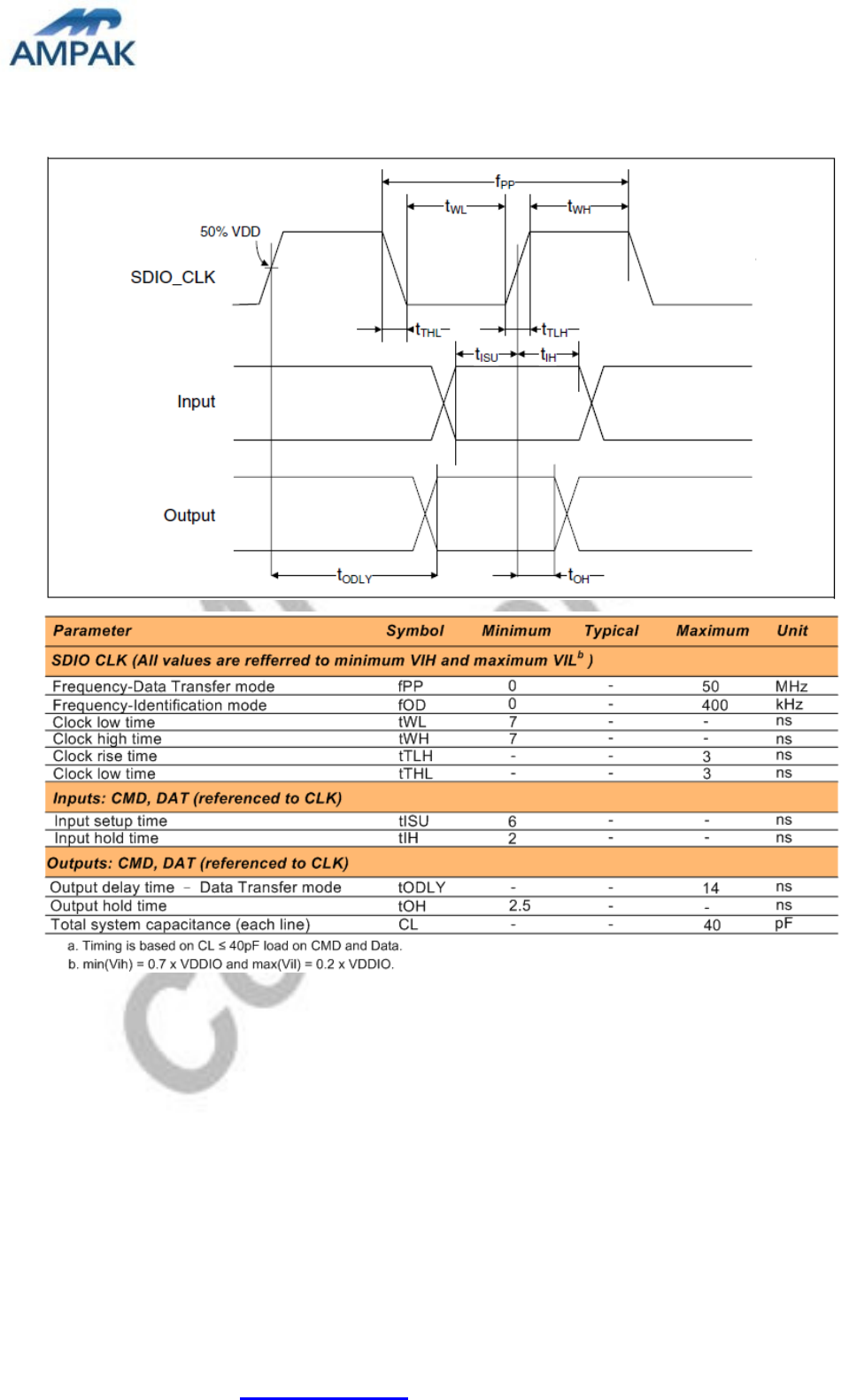
AP6234 Datasheet
AMPAK Technology Inc. www.ampak.com.tw Proprietary & Confidential Information
Doc. NO:
18
10.3 SDIO High Speed Mode Timing Diagram
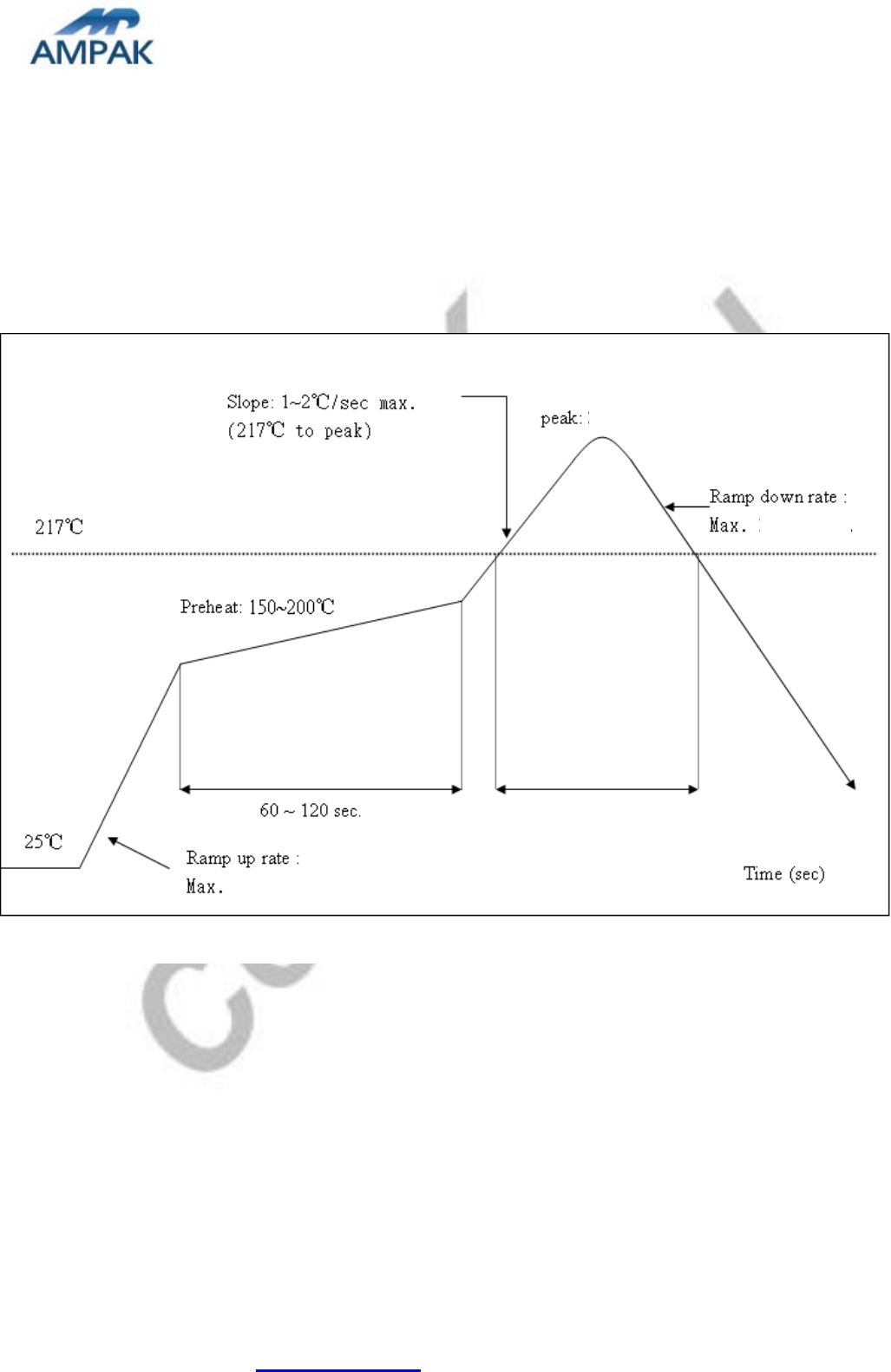
AP6234 Datasheet
AMPAK Technology Inc. www.ampak.com.tw Proprietary & Confidential Information
Doc. NO:
19
11. Recommended Reflow Profile
Referred to IPC/JEDEC standard.
Peak Temperature : <250°C
Number of Times : 2 times
2.5 /sec℃
2.5°C
/
sec
40~70 sec
250℃
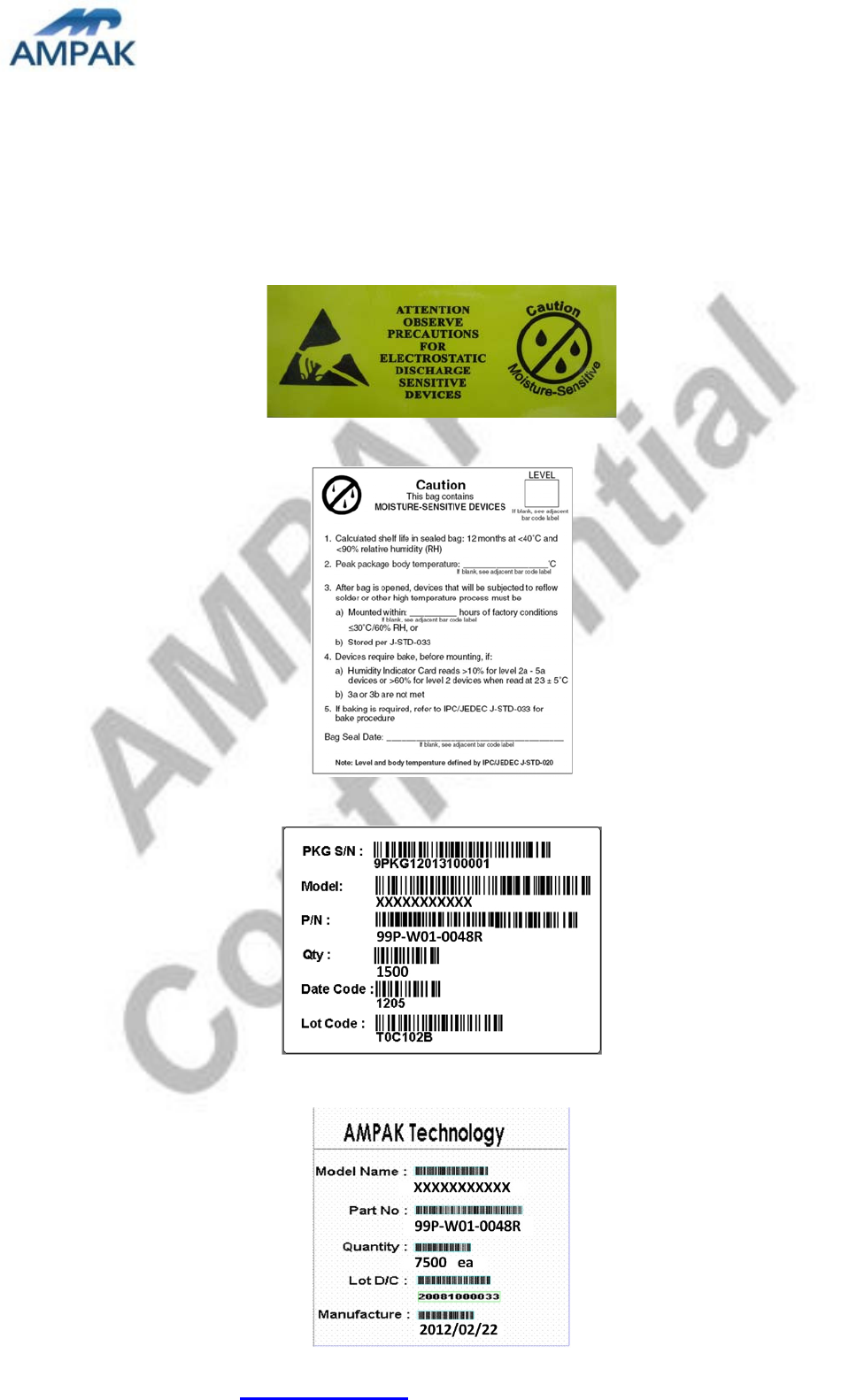
AP6234 Datasheet
AMPAK Technology Inc. www.ampak.com.tw Proprietary & Confidential Information
Doc. NO:
20
12. Package Information
12.1Label
Label A Anti-static and humidity notice
Label B MSL caution / Storage Condition
Label C Inner box label .
Label D Carton box label .
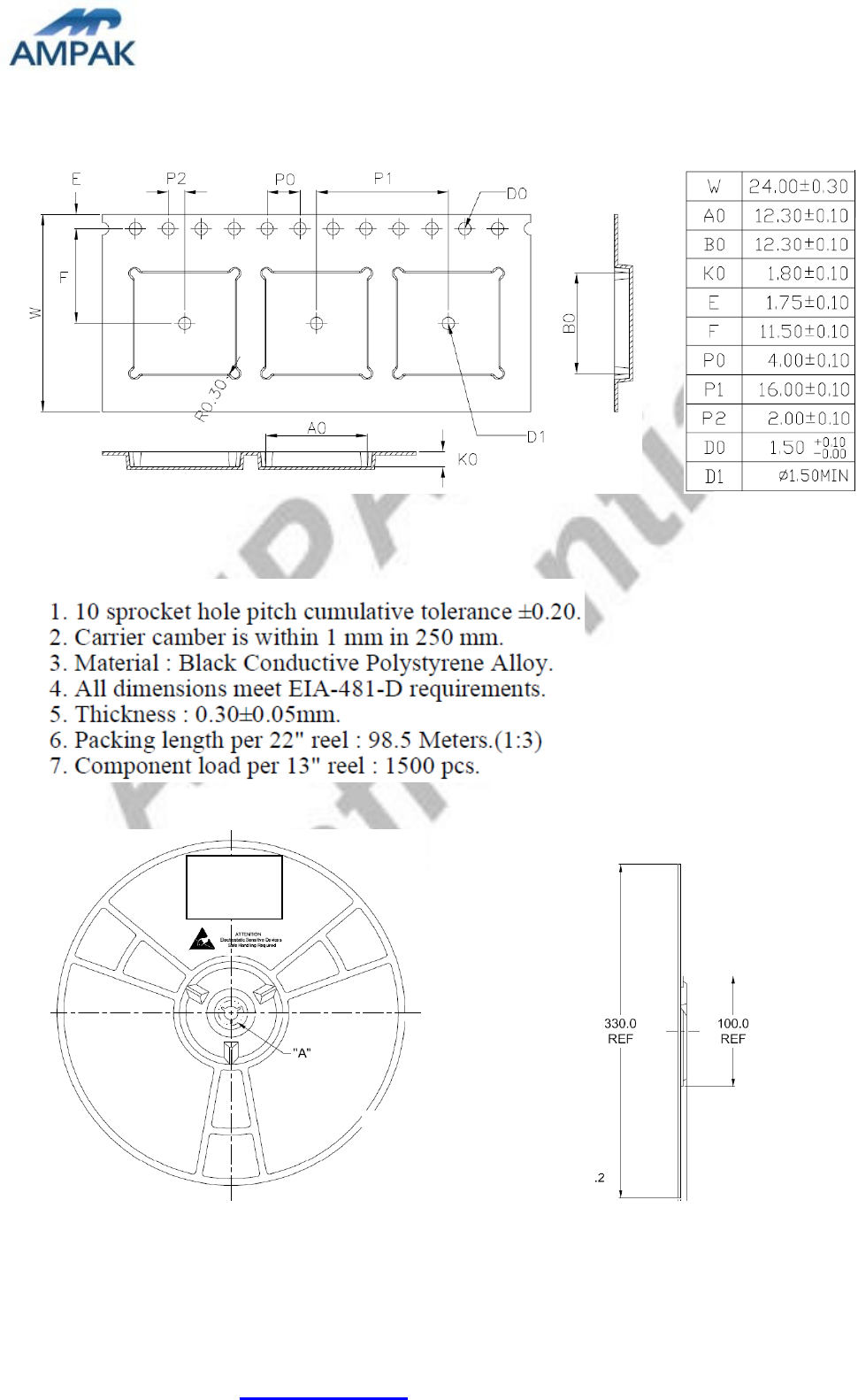
AP6234 Datasheet
AMPAK Technology Inc. www.ampak.com.tw Proprietary & Confidential Information
Doc. NO:
21
12.2 Dimension
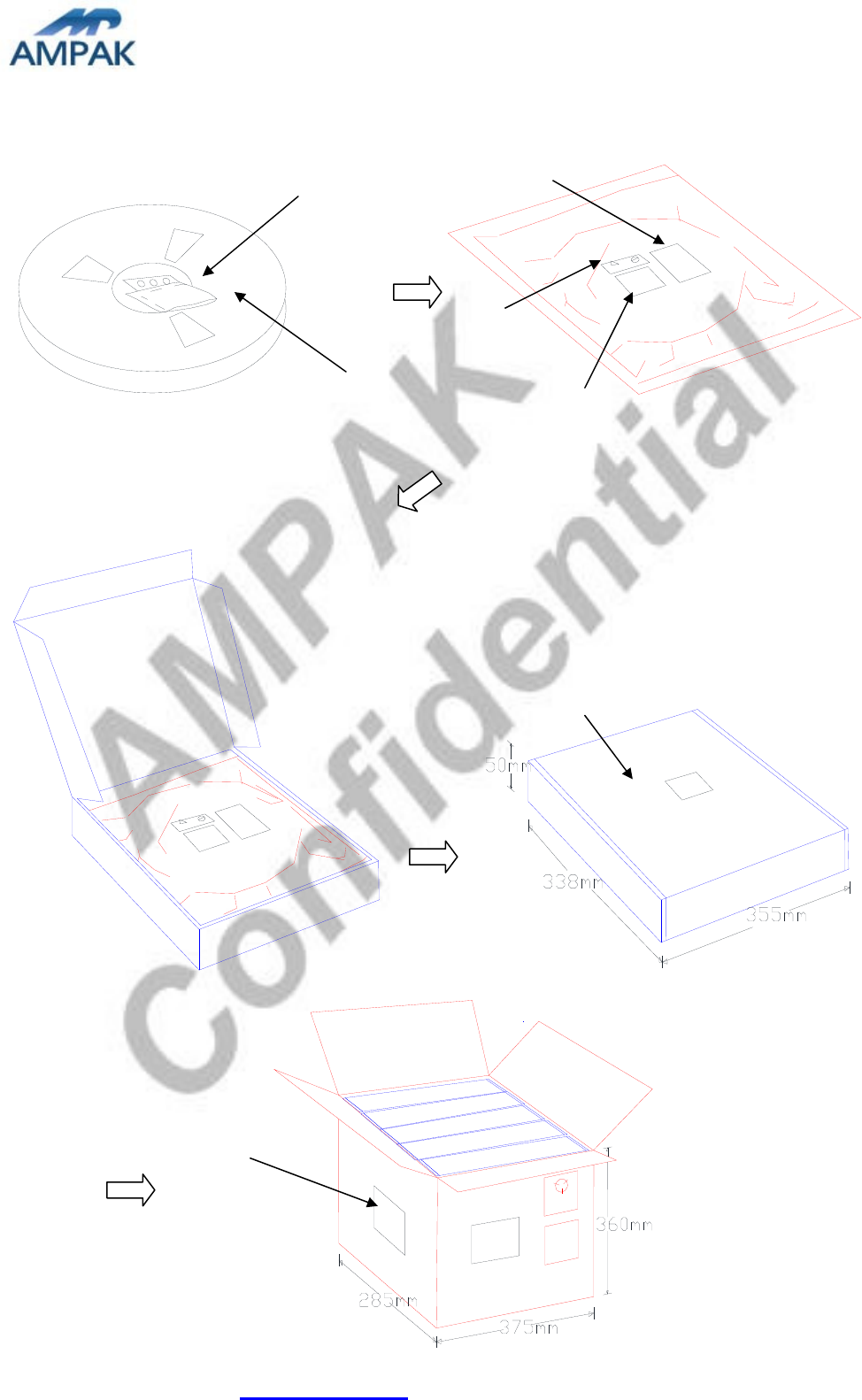
AP6234 Datasheet
AMPAK Technology Inc. www.ampak.com.tw Proprietary & Confidential Information
Doc. NO:
22
A
B
C
Humidity indicator
Desiccant
C
D
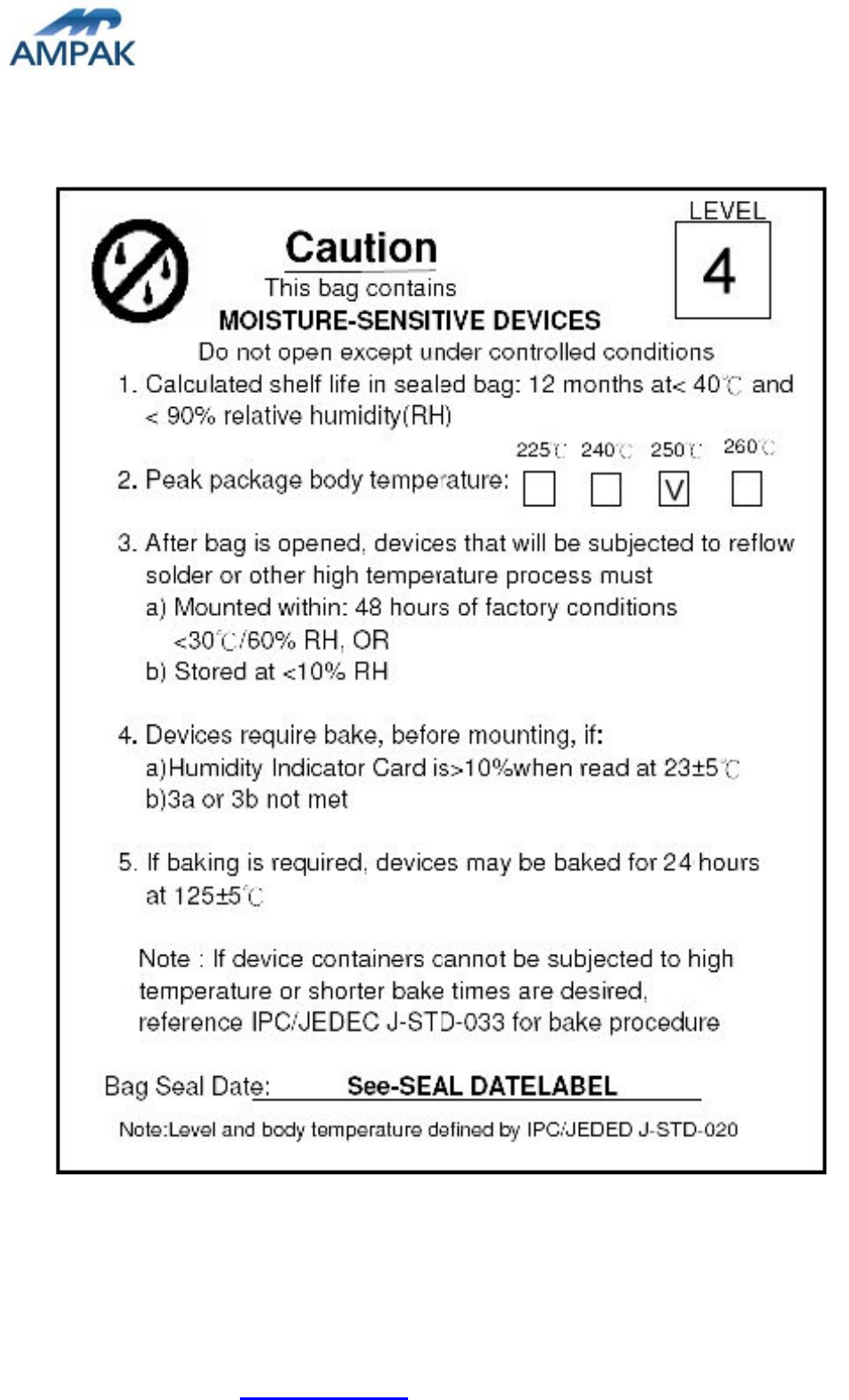
AP6234 Datasheet
AMPAK Technology Inc. www.ampak.com.tw Proprietary & Confidential Information
Doc. NO:
23
12.3 MSL Level / Storage Condition
※NOTE : Accumulated baking time should not exceed 96hrs